
Lustreware Vanity Box, Lady in Crinoline, probably continental early/mid C20th
Price: £35
Continental Figure of a Cellist, Conta and Bohme, Germany late C19th
Price: £55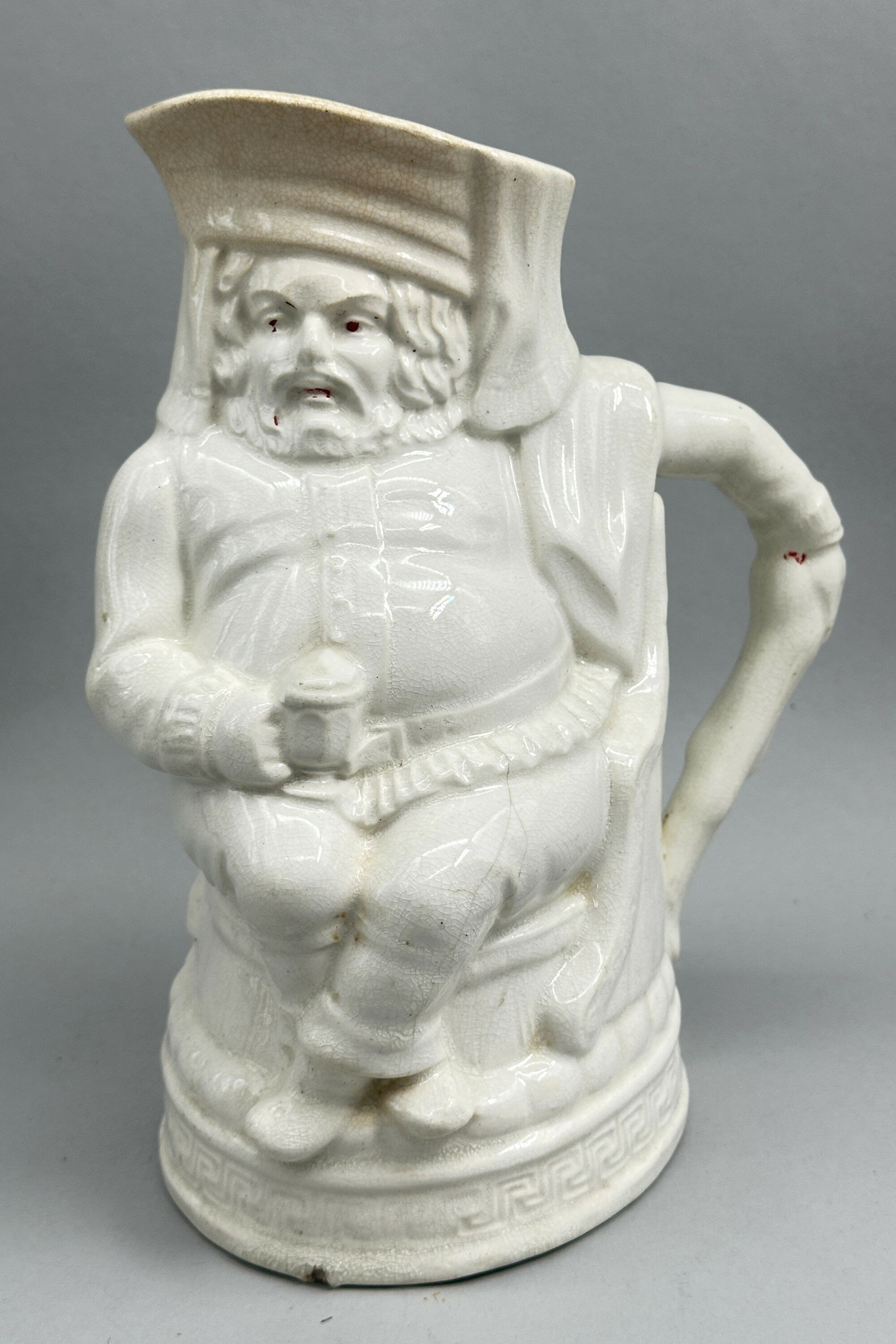
Earthenware Jug, Falstaff or Old King Cole, Furnival and Clark, mid C19th
Price: £75The design for this jug, usually termed ‘Falstaff’ but sometimes ‘Old King Cole’ is known to have been registered (Rd.No. 32601)by the firm Furnival and Clark on December 30th 1845. This was a very short lived partnership between Thomas Furnival and Richard Clark, based at the Stafford Street Pottery Works, Hanley, Staffordshire and which traded from 1844 to 1846 apparently producing just this one model, albeit in a variety of colours. Thomas Furnival had been involved in other firms before this brief venture and was to be involved in others afterwards. The dating of these mugs is usually attributed to the short period when Furnival and Clark traded but it is quite possible that more pieces were produced afterwards by Furnival himself. The paste and finish of this piece, though, which is not marked, certainly suggest a mid nineteenth century dating. In general, the model is quite rare. Some examples were fitted with a Britannia metal or pewter lid but this was never integral to the piece. This striking composition, then, is a rare and desirable item collectors with an interest in British Staffordshire wares.
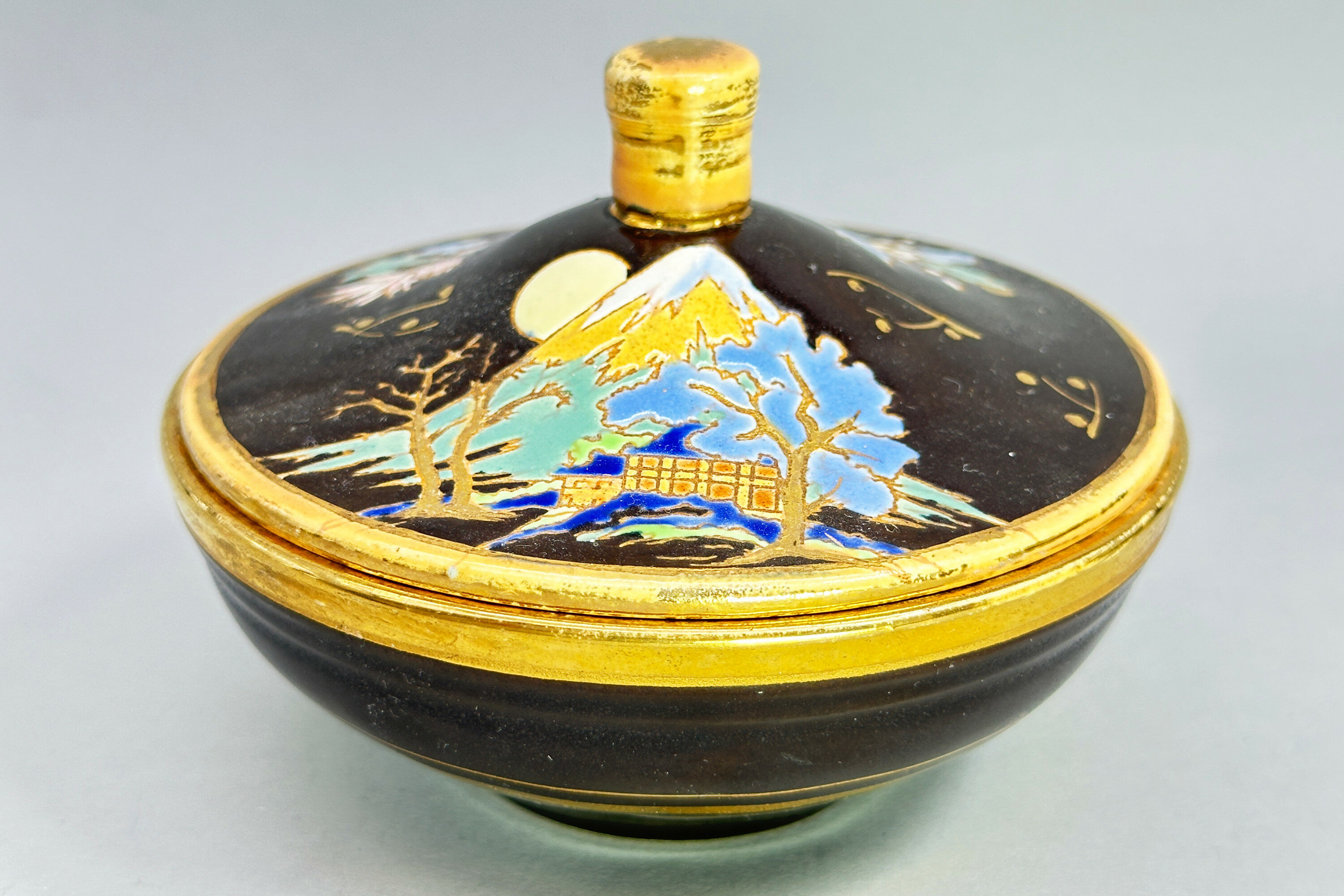
Cosmetic Box with Japonaiserie Decoration, Boch Freres, early C20th
Price: £45The firm Boch Freres Keramis was founded by Eugene and Victor Boch and their brother-in-law, Jean Baptiste Nothomb, in 1841 and was located in La Louviere in eastern Belgium. In 1906 Charles Catteau joined the company as artistic director and was responsible for a new and wide ranging series of designs, some under the influence of Japonisme, transitioning the company from producing utilitarian objects to highly decorative ceramics. His work can clearly be seen here in a piece which appears to be quite unusual. Both the form and the decoration reflect early twentieth century fashion in the clean lines and the images inspired by Japan. There is a hint of the aesthetic movement here producing an object of great attraction and interest.
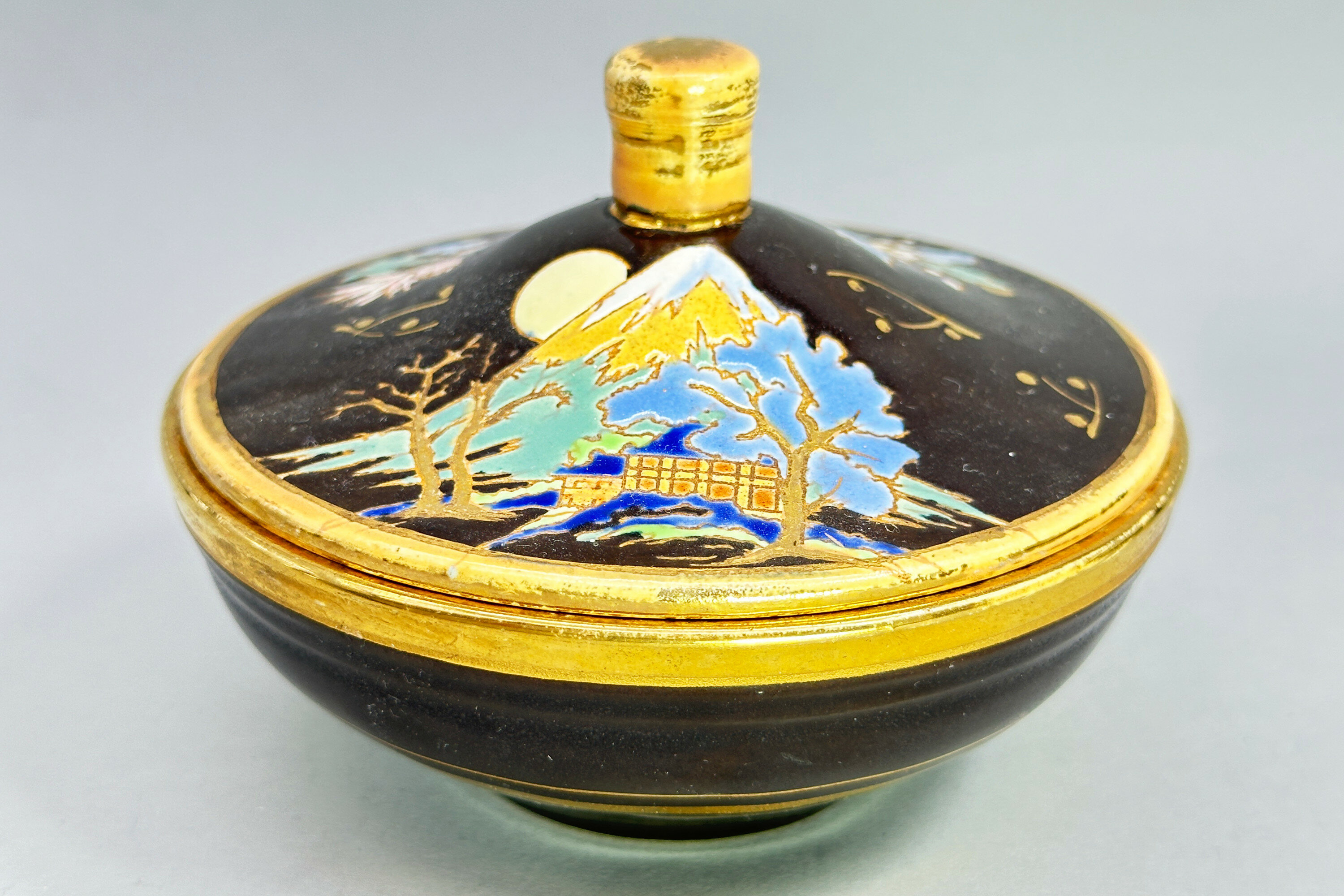
Cosmetic Box with Japonaiserie Decoration, Boch Freres, early C20th
Price: £45The firm Boch Freres Keramis was founded by Eugene and Victor Boch and their brother-in-law, Jean Baptiste Nothomb, in 1841 and was located in La Louviere in eastern Belgium. In 1906 Charles Catteau joined the company as artistic director and was responsible for a new and wide ranging series of designs, some under the influence of Japonisme, transitioning the company from producing utilitarian objects to highly decorative ceramics. His work can clearly be seen here in a piece which appears to be quite unusual. Both the form and the decoration reflect early twentieth century fashion in the clean lines and the images inspired by Japan. There is a hint of the aesthetic movement here producing an object of great attraction and interest.
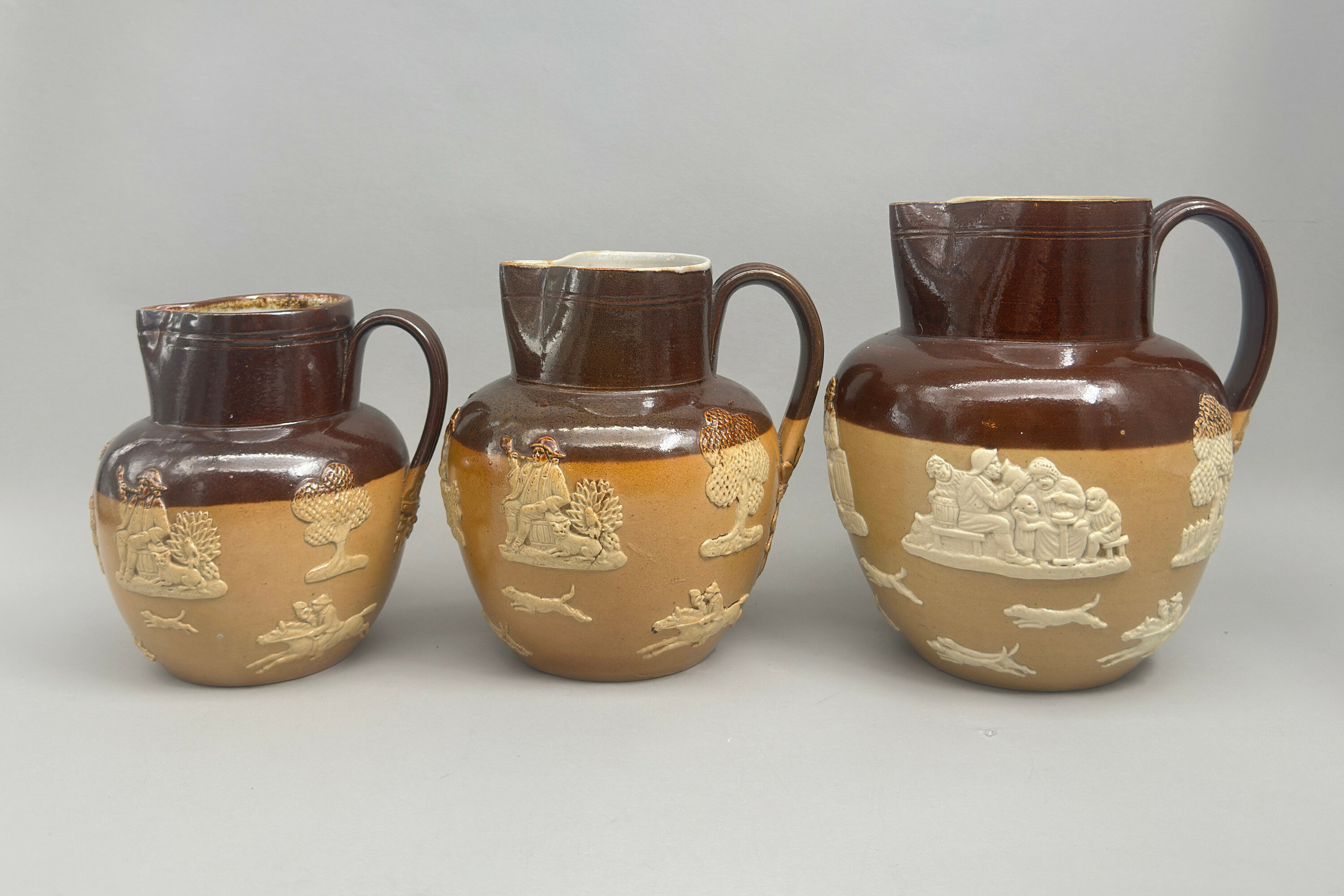
Graduated set of three Royal Doulton Harvest Pattern Jugs, early C20th
Price: £150While this model, often called the ‘harvest pattern’, is found quite often, it is very unusual to see a graduated set of three, all matching. The form of the mark, where the lion does not sit above a crown, was used between 1922 and 1927 which gives us the dating here. The largest jug carries the letter ‘a’ which was a decorator’s mark and stands for Louisa Ayling. Perhaps she worked on all three, but this must remain a guess although the quality of the work on all three is quite consistent producing a highly decorative and attractive ensemble.
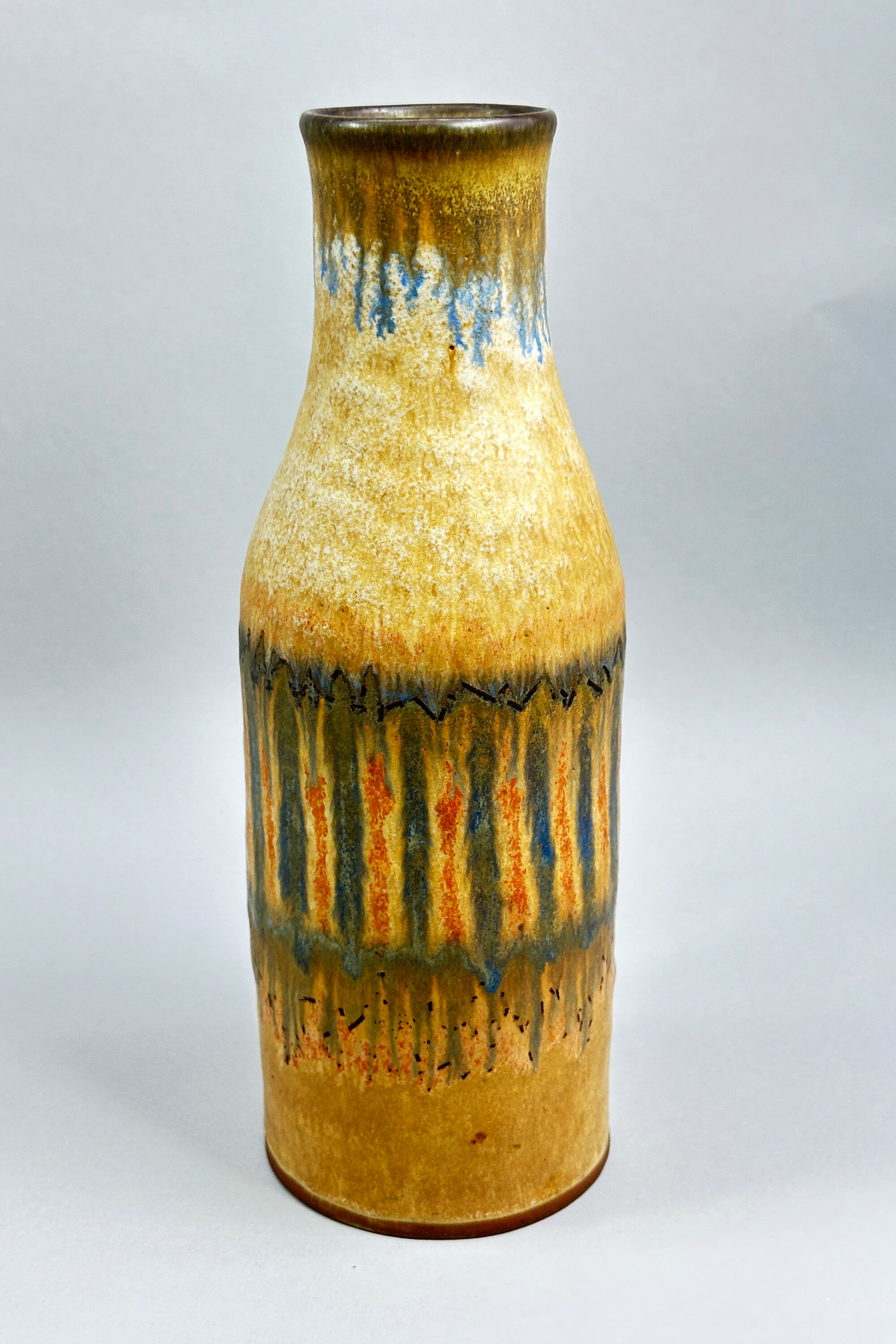
Studio Pottery Vase signed Kamini, Greece, 1970s
Price: £45Although ‘Kamini’ is both the Greek word for a kiln and the name of a village on the Greek island of Hydra, it actually stands here for the Greek firm of that name whose registered office was at Kallithea, a suburb of Athens. The Kamini pottery produced a wide range of appealing but often slightly rustic wares in the 1970s, many with the splash glaze effects we see here and all stamped with the firm’s name. This vase stands out somewhat for the simple lines of its form and the variety of effects in its decoration with a particularly pleasing palette of colours and demonstrates that this Mediterranean pottery could well rival at times the work of some of its European competitors.

West German Vase with drip glaze decoration, Scheurich, 1960s
Price: £45Although not marked as such, this vase has all the hallmarks of the firm Scheurich Keramik which started production in 1954, rather later than most of its competitors, but soon became the largest producer of commercial art pottery in Germany. Their pieces rarely carried the factory name but usually the model number followed by the height in centimetres with ‘W-Germany’ below, as here. Model ‘517’ can be found in a variety of different glazes but the colourings here with the contrast between browns and cream are particularly successful. Dating is to the 1960s.

An Art Deco ceramic group of two Fish by Guido Cacciapuoti, signed, 1930s
Price: £150Guido Cacciapuoti was a celebrated Italian ceramicist. Born in Naples in 1892 and from a family with a tradition in the creation of majolica pottery, Guido exhibited his work widely in the 1920s and finally, in collaboration with his brother, Mario, and Angelo Bignami as the administrative and commercial director, he founded the factory ‘Gres d'Arte Cacciapuoti Bignami & C.' in Milan in 1927. Mario unfortunately died three years later leaving Guido to carry on on his own until his death in 1953.
In the 1930s, Guido’s workshop became famous for the production of ceramic animal sculptures with fish being a particular speciality. More commonly seen are groups of John Dory, again with a red glaze, but the smoother lines here and the particularly intense colour reflect more closely the contemporary Art Deco style. Sought after in their own time, with patrons such as the King of Italy and Mussolini, Guido’s works are highly collectible today and this group would make a striking addition to a collection of Art Deco ceramics with considerable decorative appeal.
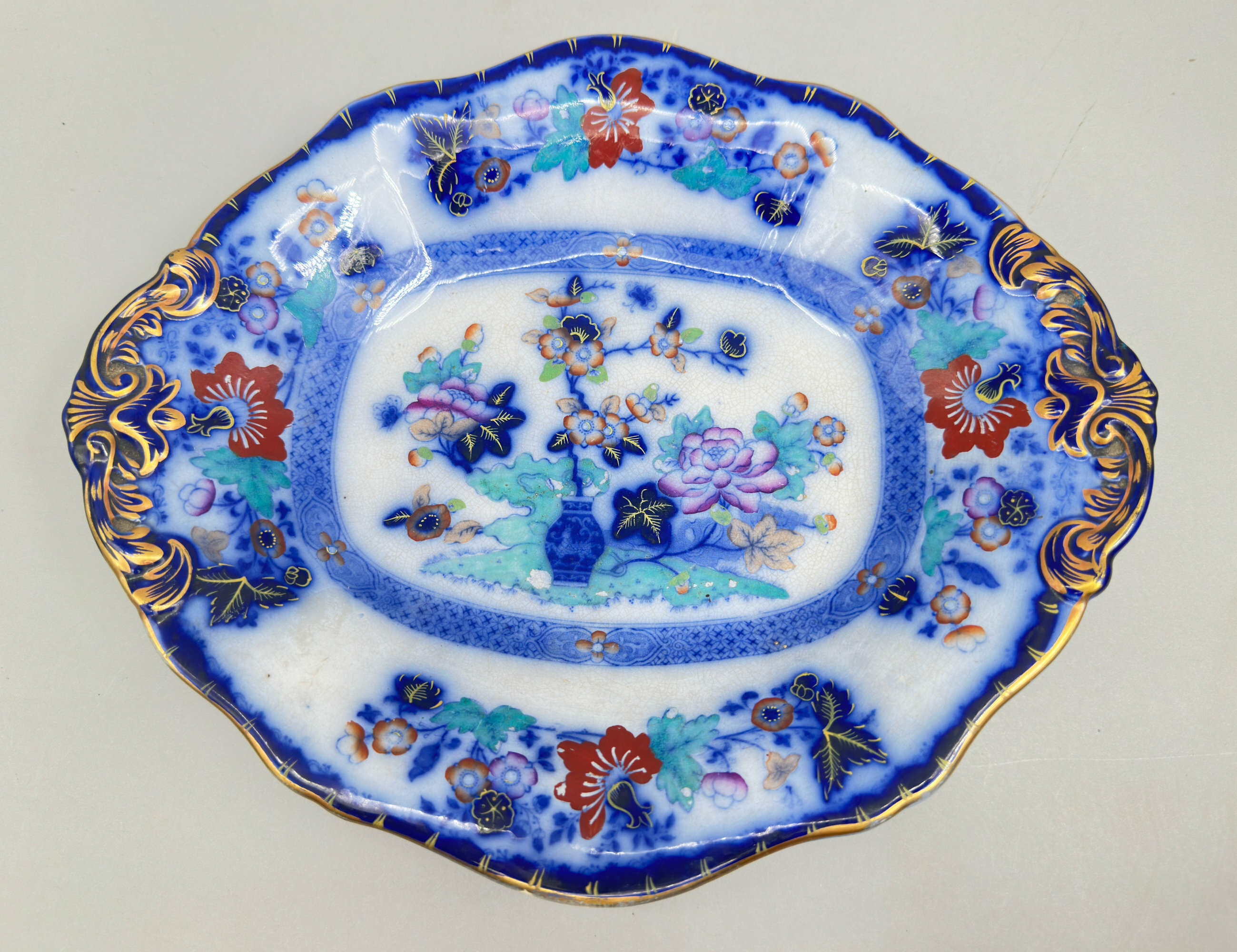
Bombay Japan pattern deep Dish, Minton or Samuel Alcock, English mid C19th
Price: £25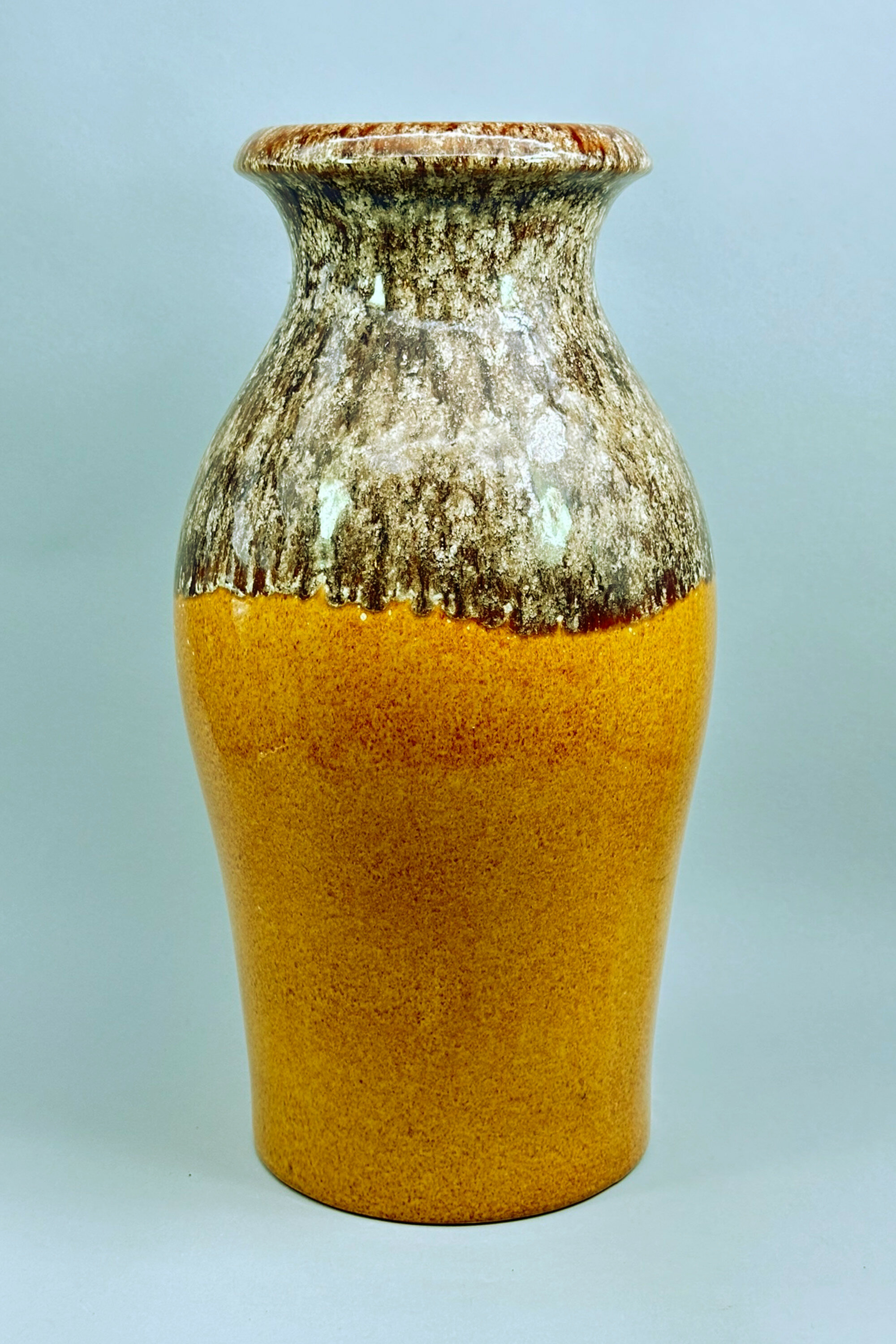
West German ceramic Vase, Scheurich, No 290-40, 1960s
Price: £55Although not marked as such, this vase has all the hallmarks of the firm Scheurich Keramik which started production in 1954, rather later than most of its competitors, but soon became the largest producer of commercial art pottery in Germany. Their pieces rarely carried the factory name but usually the model number followed by the height in centimetres with ‘W.Germany’ below, as here. Scheurich were well known for producing a wide variety of pieces with variegated, almost experimental glazes and this vase is yet another successful example of their work, the simple lines of form combining with a more austere selection of glaze effects than found in some of their other pieces. Dating is to the 1960s.

Continental Earthenware Vase with geometric motifs in the style of Amphora, C20th
Price: £45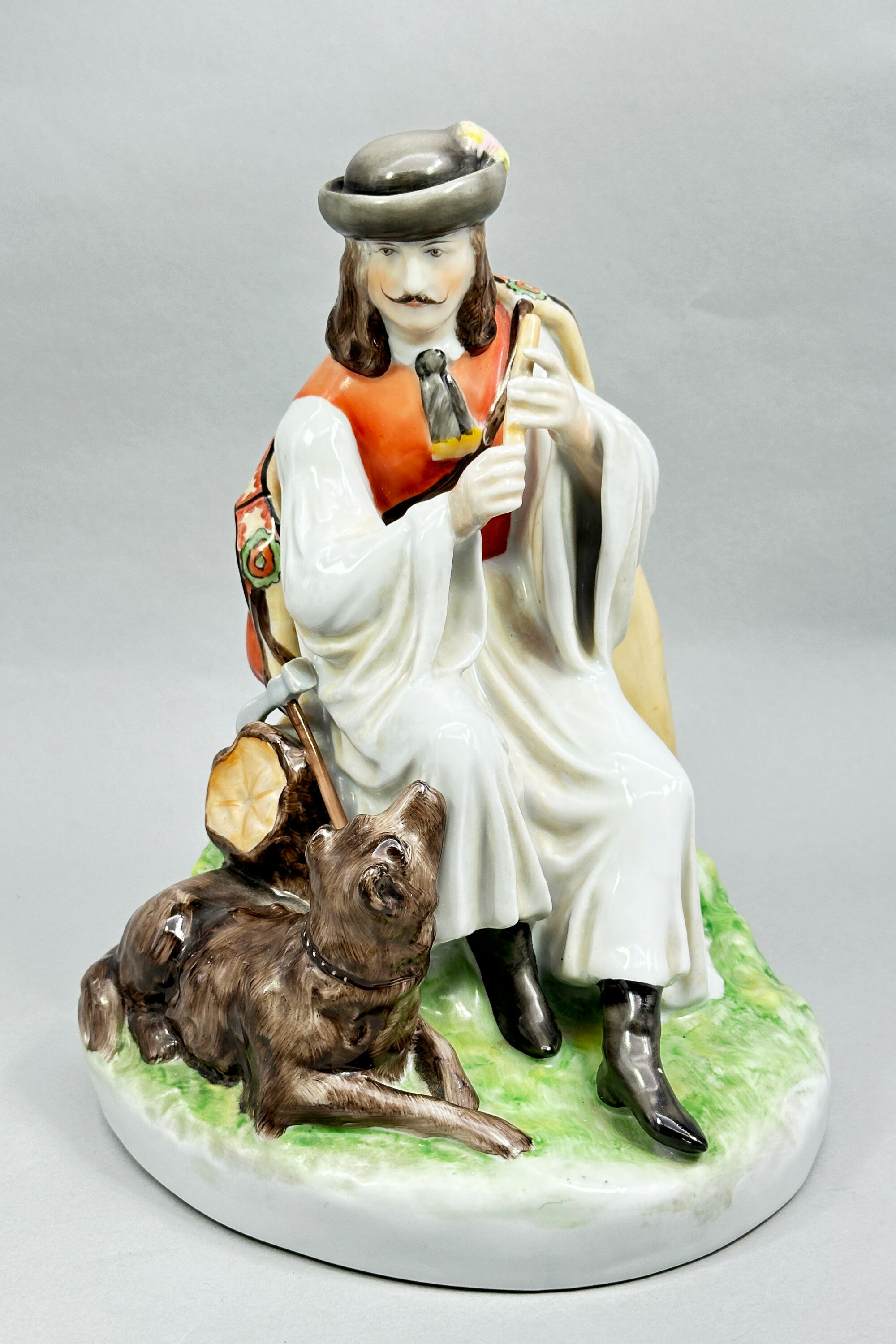
Figure of a Seated Huntsman, Zsolnay Pecs, 1970s
Price: £55The mark is for the well known ceramics manufacturer Zsolnay, based in Pecs, Hungary. Founded by Miklos Zsolnay in 1853, the firm gained a worldwide reputation in the late nineteenth century exhibiting at international fairs and exhibitions. Production declined after the first world war and the factory was bombed during the second. Revived under communism in 1948, the firm started to produce utilitarian pieces under the name ‘Pécs Porcelain Factory’ but gradually their traditional wares were revived and the Zsolnay name was restored in 1982.
This figure is one of the products of Zsolnay’s late renaissance but dating to the 1970s, as indicated by the form of the mark, it still carries only the Pecs brand name. But the quality typical of Zsolnay is emphatically there with fine quality porcelain and careful modelling and decoration all combining to produce a most decorative and attractive composition.
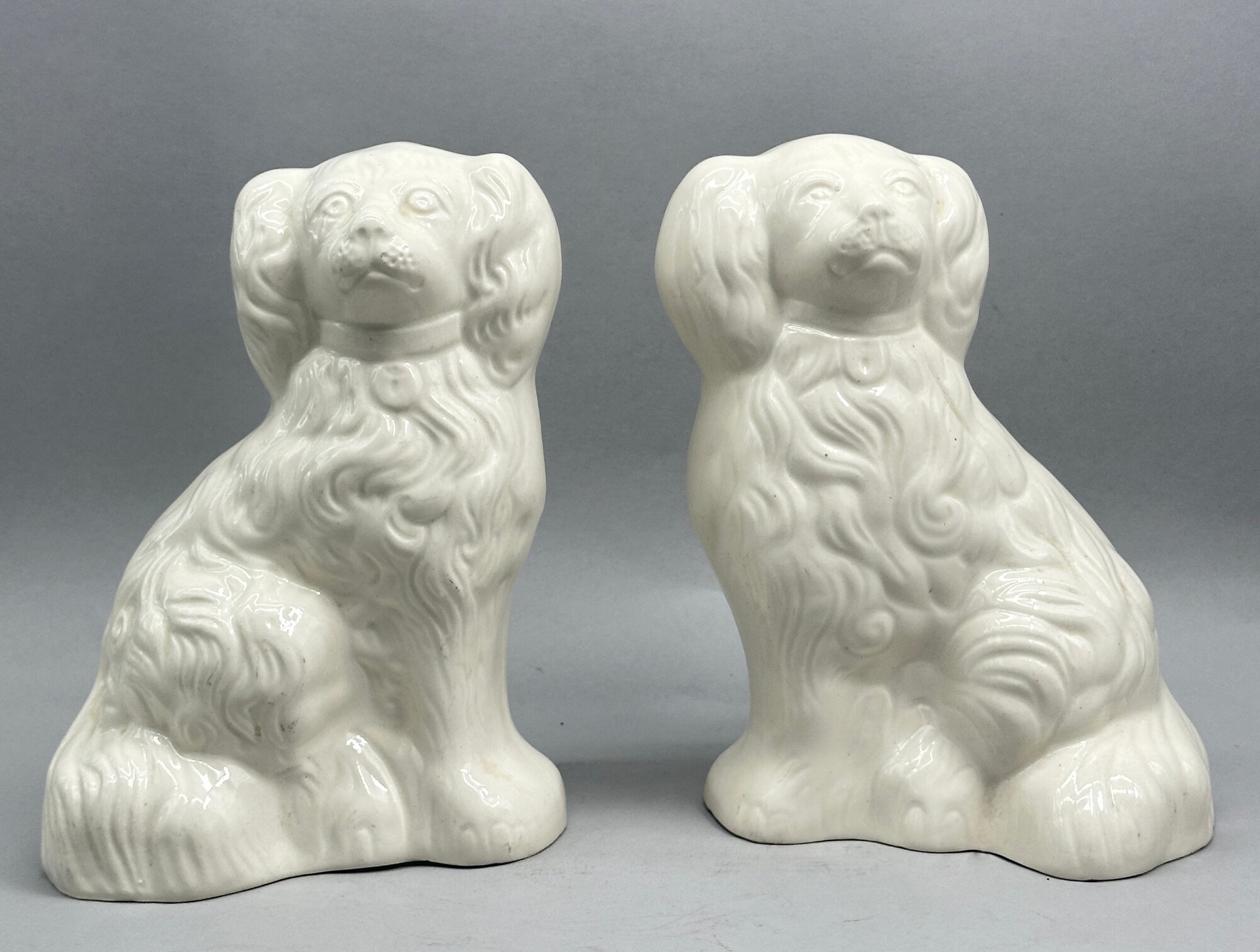
An unusual pair of white glaze models of Spaniels, Beswick, 1960s
Price: £75While a close relation to the traditional Victorian ‘Staffordshire Dog’, these figures were actually made by the English firm Beswick in the twentieth century. Founded in 1894 by James Beswick and his sons, the company became known for its output of figurines, eventually securing the rights to producing characters from the novels of Beatrix Potter and the films of Walt Disney. It was sold to Royal Doulton in 1969 who continued production until 2002, selling the pottery premises in 2003 and the rights to the name in 2004 when they were bought by Dartington Crystal who still manufacture pieces carrying the Beswick name. These spaniel figures appear to date from the 1960s and were made in at least two sizes. Most have painted decoration but the plain white finish here is really the most pleasing of all producing a pair of decorative items with timeless appeal.
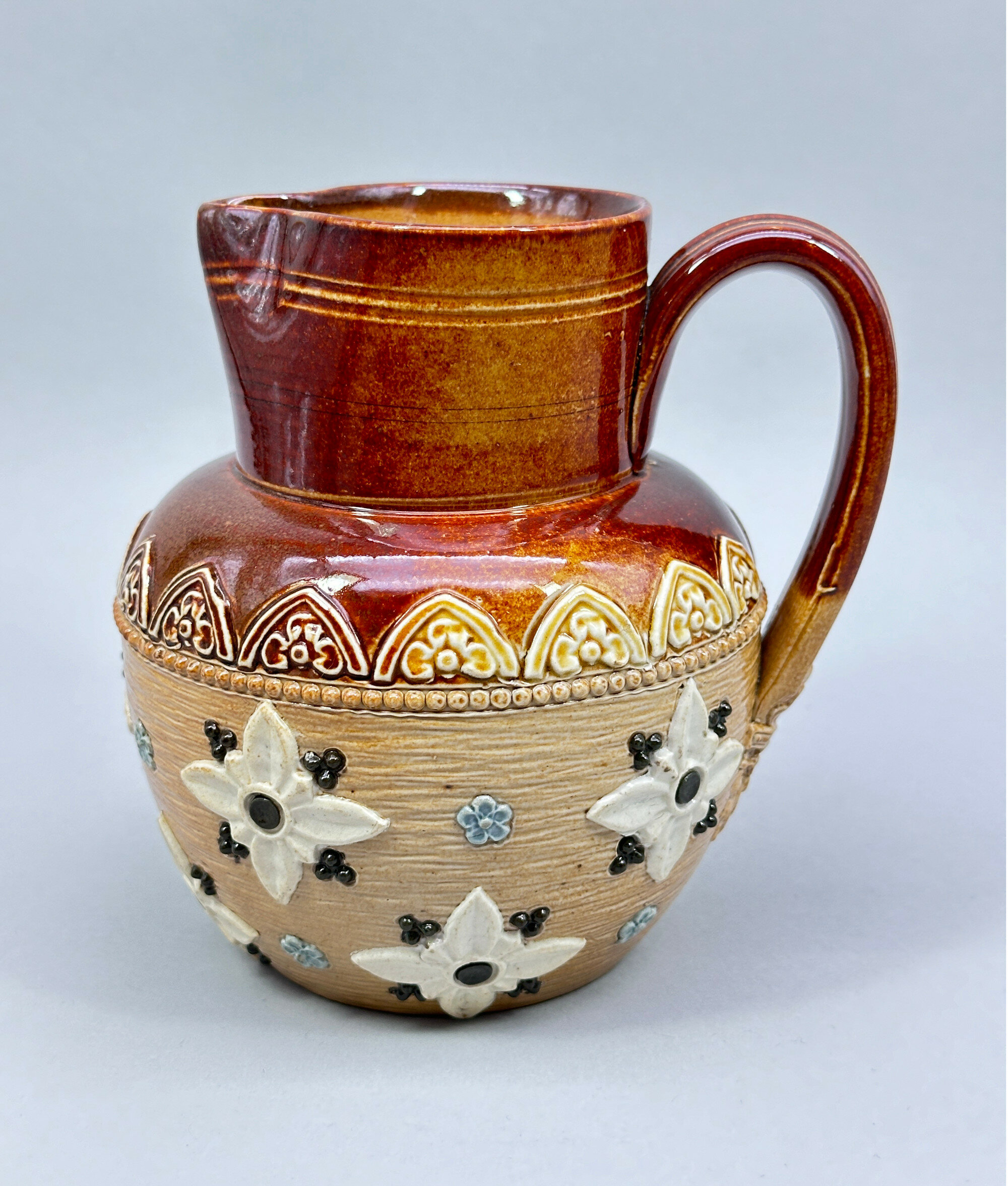
Doulton Lambeth Stoneware Jug circa 1900
Price: £45
West German Vase, Model No 517-38, Scheurich, 1960s
Price: £55Although not marked as such, this vase has all the hallmarks of the firm Scheurich Keramik which started production in 1954, rather later than most of its competitors, but soon became the largest producer of commercial art pottery in Germany. Their pieces rarely carried the factory name but usually the model number followed by the height in centimetres with ‘W.Germany’ below, as here. Model ‘517’ can be found in a variety of different glazes but the pattern and colourings here, more muted than some of Sheurich’s work and with a matt finish, are particularly pleasing and complement the elegant form most successfully. Dating is to the 1960s.
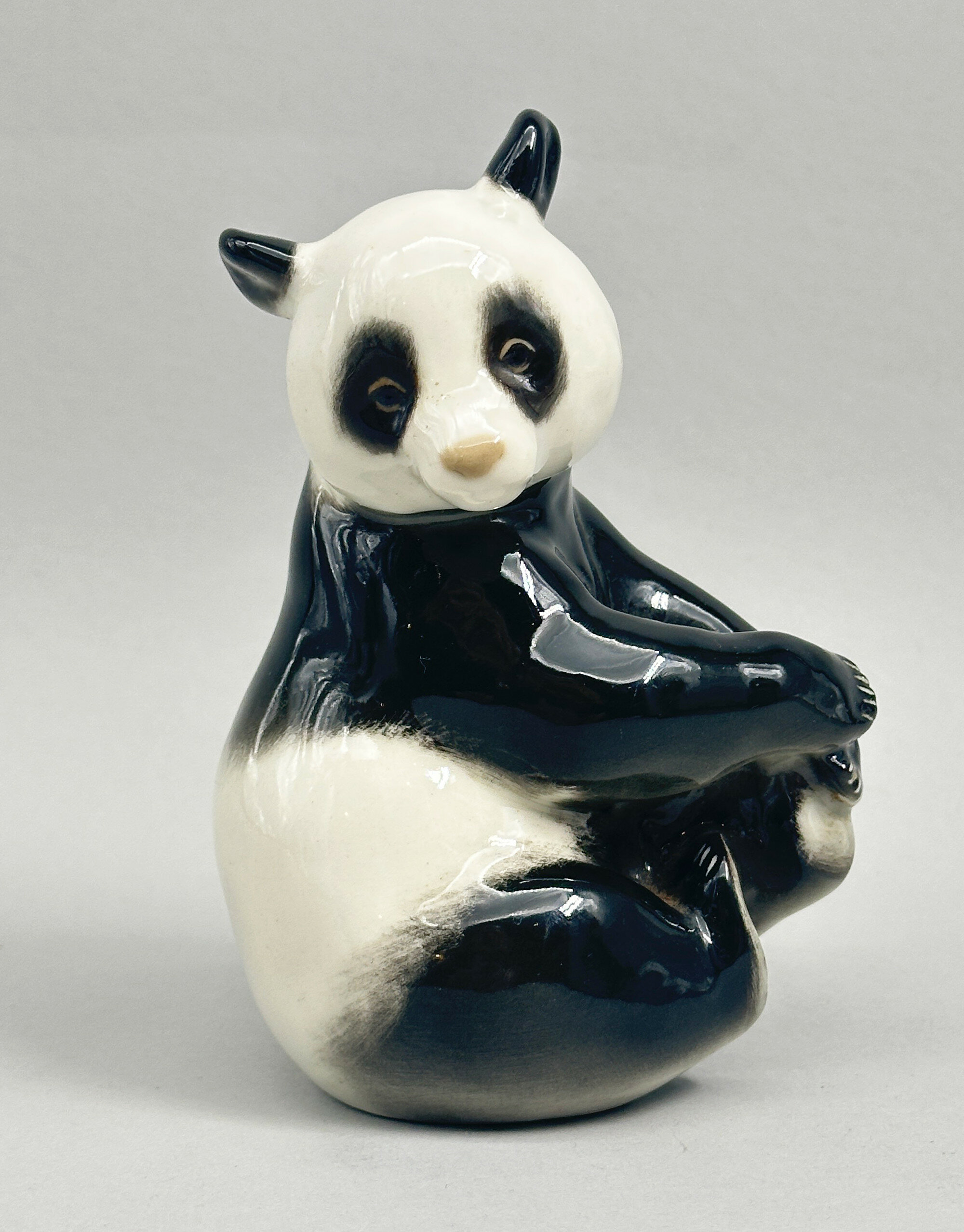
Porcelain Figure of a seated Panda, Lomonosov, USSR late C20th
Price: £25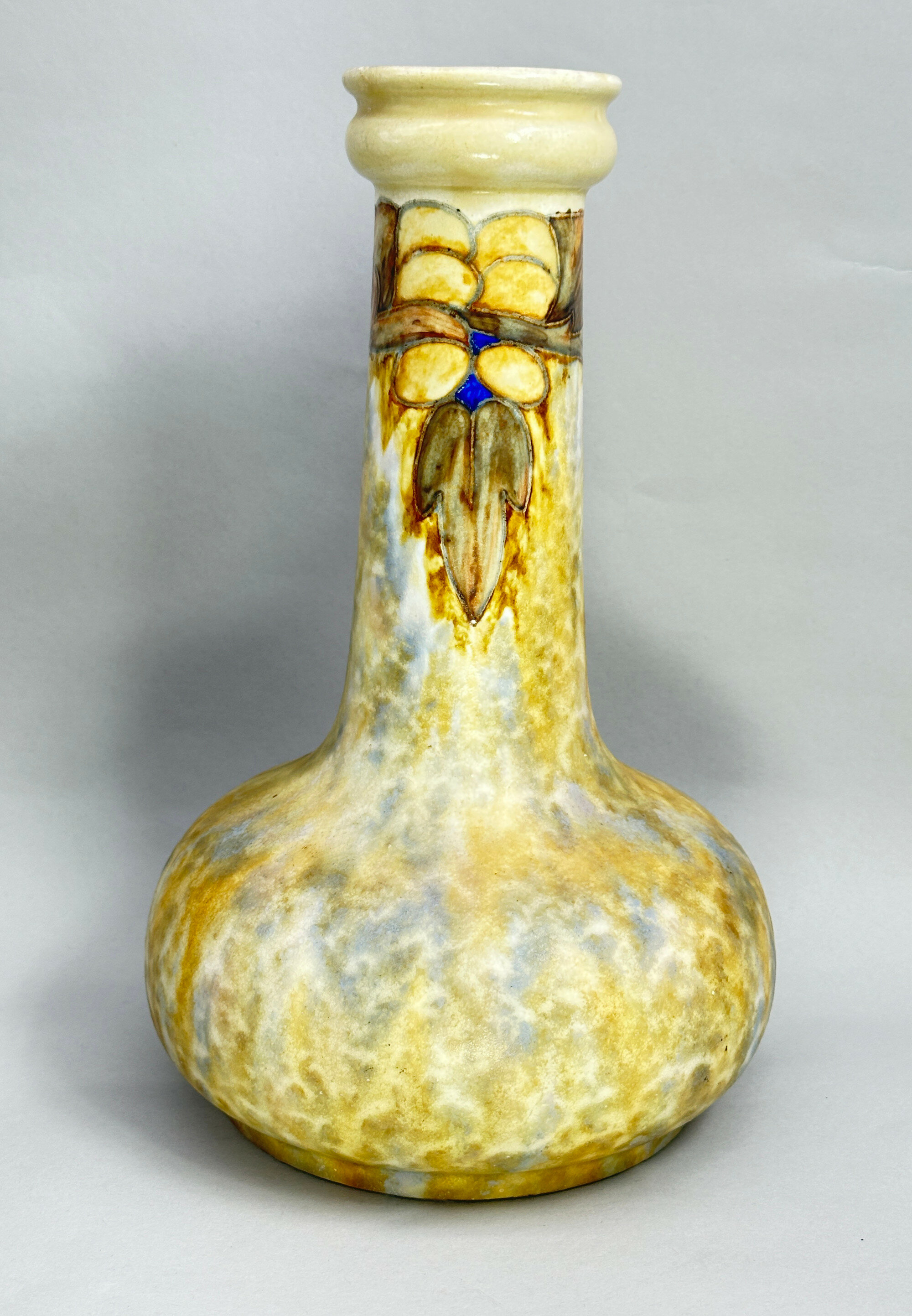
Cranston Ware Art Nouveau Style Vase, early C20th
Price: £95Cranston Ware was one of the ranges produced by the Pearl Pottery Company, based in Hanley, Stoke on Trent. Founded in 1892, the firm produced a varied selection of ceramic wares, often following contemporary fashions, until its closure in 1947. This vase is demonstrably in the Art Nouveau style and would have been produced when it was at its zenith in the early 1900s. The pattern was known as ‘Tukan’ ware and some of the pieces, but not all, have an impressed mark displaying this. This is an excellent example of the type with the glazes and decorative detail well rendered and certainly deserves the attention of collectors of Art Nouveau.
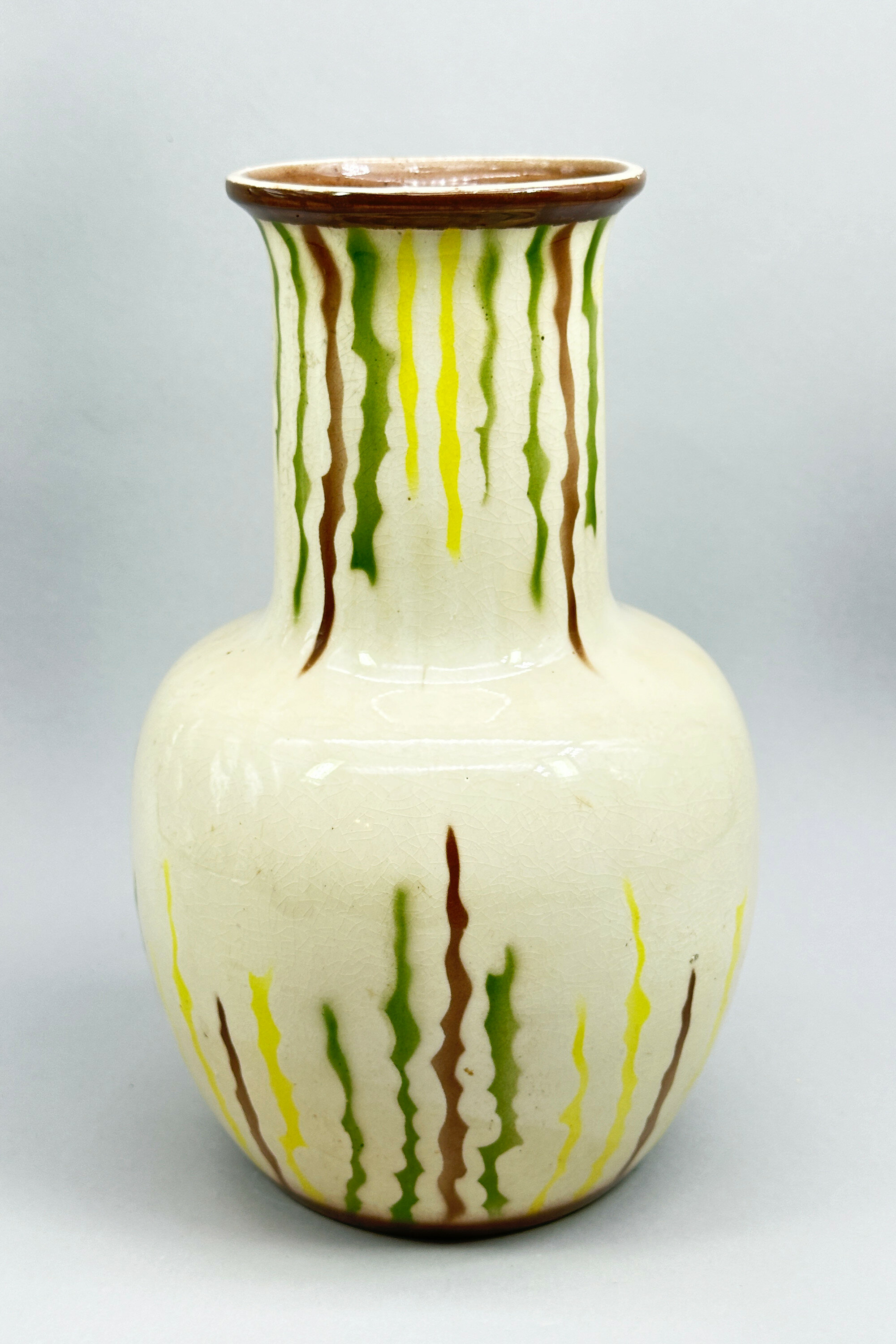
Art Deco style Vase signed E.Radford, mid C20th
Price: £75There were, in fact, two craftsmen working in the C20th British pottery industry with the name Edward Radford, father and son. Radford senior worked for Pilkington’s Royal Lancastrian Pottery in Manchester from 1903 until his retirement in 1936, acting as their main thrower. Radford junior joined his Father in 1905, but the First World War intervened, in which he won a Military Cross for his actions at Passchendaele in 1917 and afterwards he settled in Stoke on Trent, the heart of Britain’s pottery industry. An association developed with H.J.Wood’s Alexandra Pottery in Burslem who produced a range of wares bearing his name in the 1930s, although Radford himself may have acted as more a salesman than the designer. Production continued after the war and even after Radford’s retirement in 1948. The form of mark used here implies the later dating but may have been used earlier. The impressed figures indicate model number. Even if this vase is post war, the style is emphatically that of pre war Art Deco period with the simple lines of the form accompanied by semi abstract decoration vaguely reminiscent of Clarice Cliff combining to produce a piece of timeless attraction.
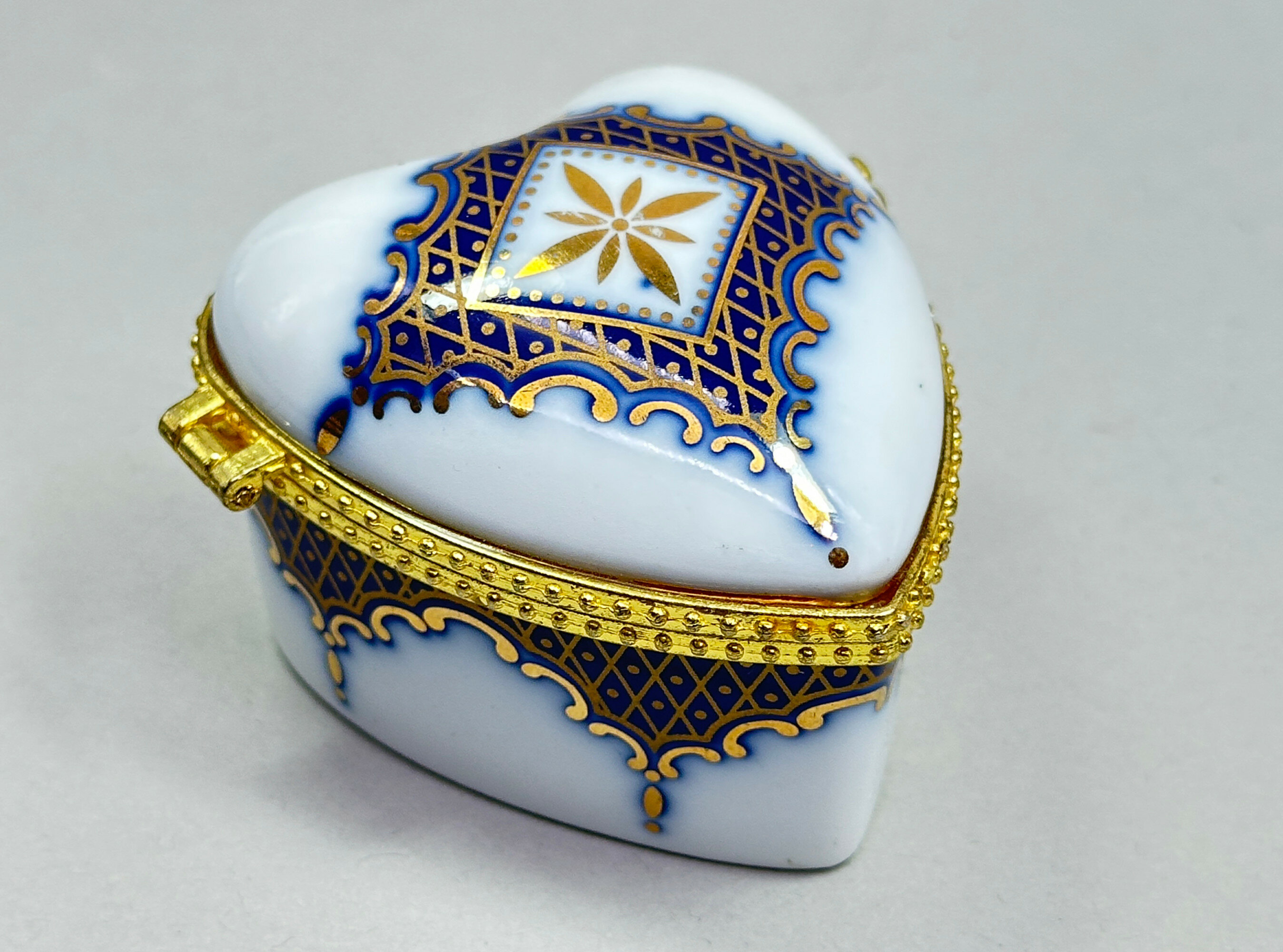
Oriental porcelain European Style Heart Shape Box and Cover, OC & CO, late C20th
Price: £15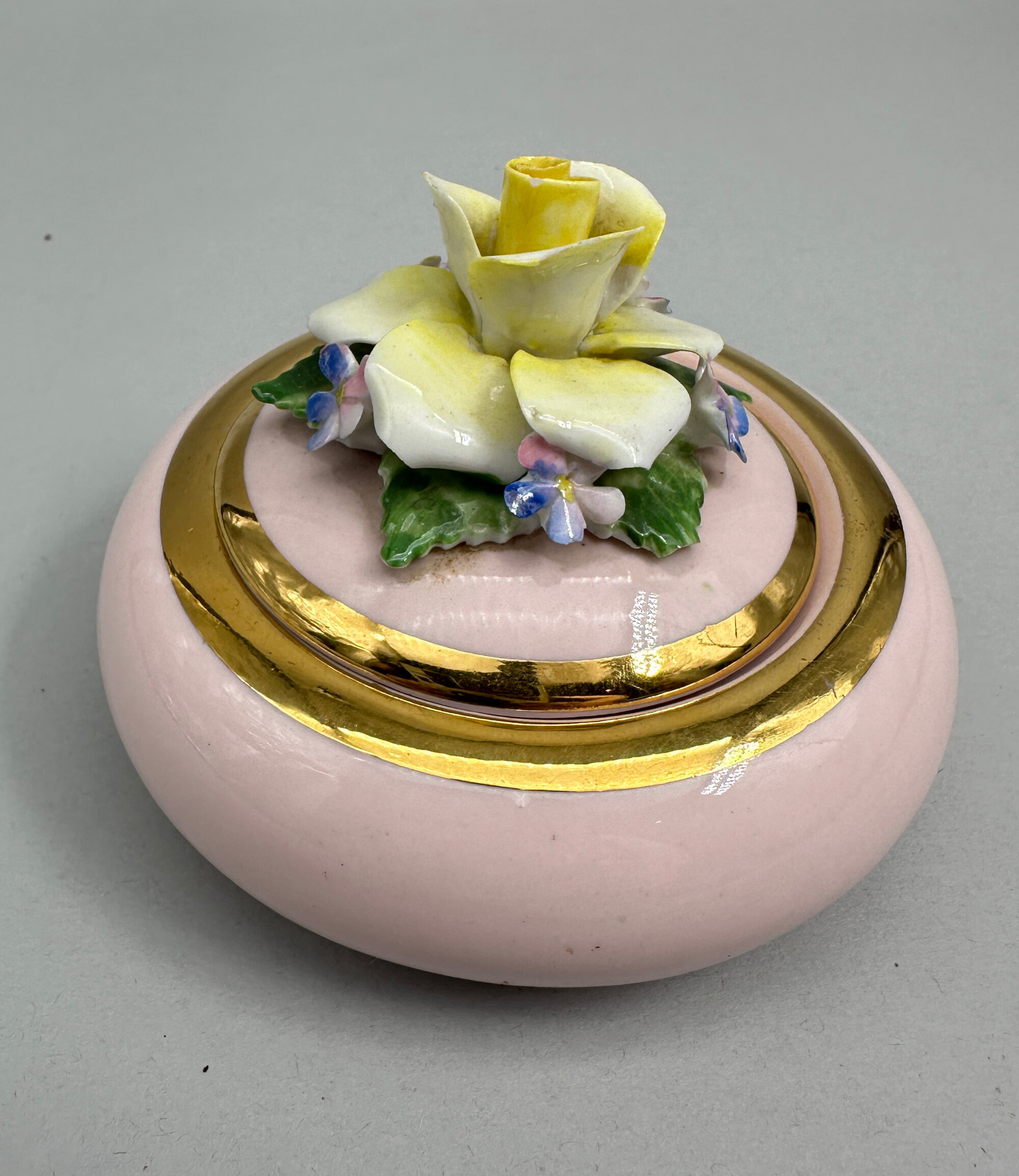
Pink porcelain powder box, Radnor Bone China, English Staffordshire, 1950s
Price: £15Radnor was the trade name used by Hall Bros (Longton) Ltd. Hall Brothers was a China manufacturer based at the Radnor Works, Longton, Stoke-on-Trent, England which traded from 1947 until its liquidation in 1972. It produced figures, birds, toby jugs and floral ware, mainly small porcelain boxes which were distinguished by their decoration of finely modelled flowers (see image XX for an advert from the 1960s). This box is a typical example and survives in excellent condition with just a very small amount of near inevitable damage to the petals.
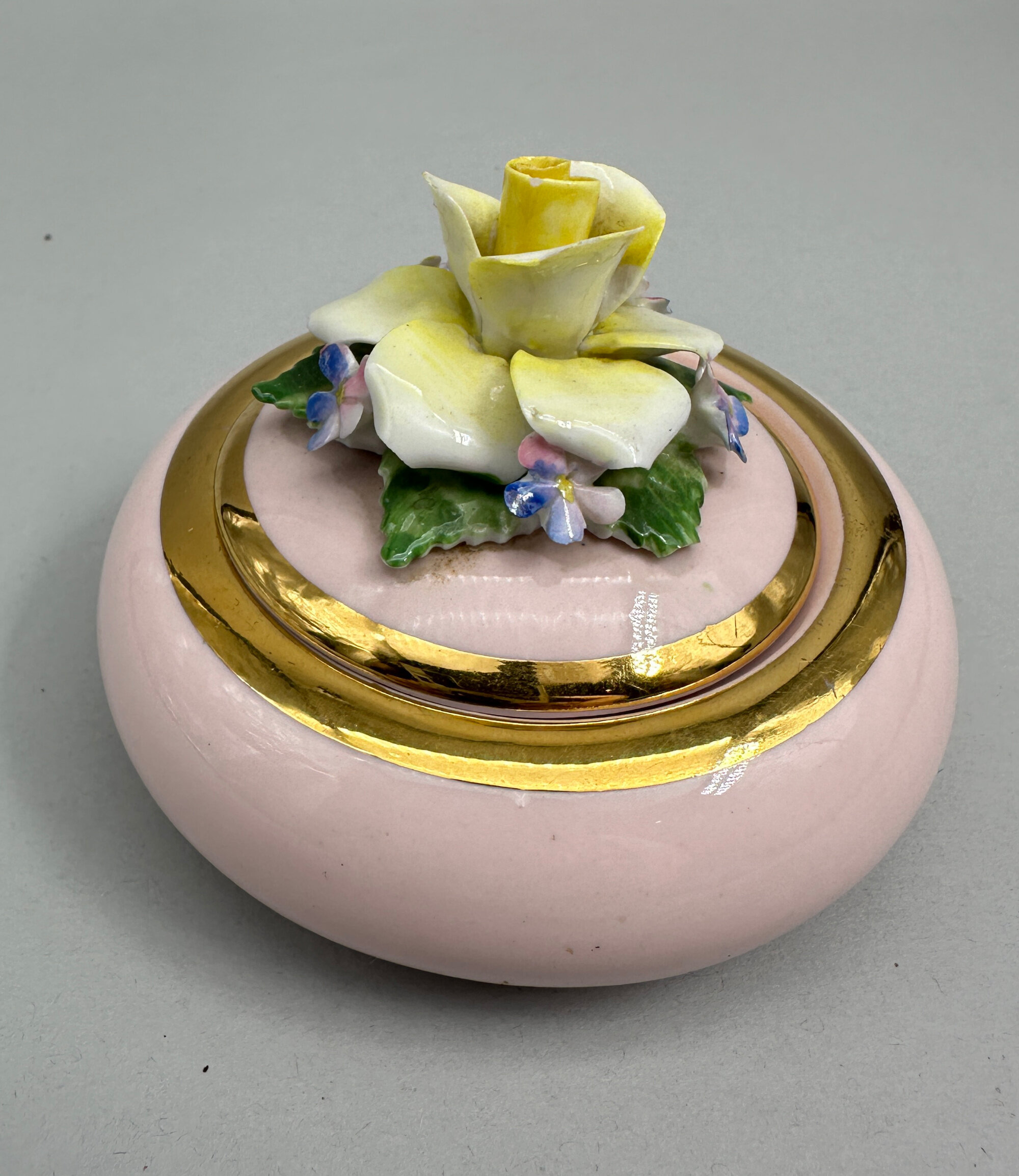
Pink porcelain powder box, Radnor Bone China, English Staffordshire, 1950s
Price: £15Radnor was the trade name used by Hall Bros (Longton) Ltd. Hall Brothers was a China manufacturer based at the Radnor Works, Longton, Stoke-on-Trent, England which traded from 1947 until its liquidation in 1972. It produced figures, birds, toby jugs and floral ware, mainly small porcelain boxes which were distinguished by their decoration of finely modelled flowers (see image XX for an advert from the 1960s). This box is a typical example and survives in excellent condition with just a very small amount of near inevitable damage to the petals.

Gilt decorated English porcelain powder box and cover, probably mid C20th
Price: £15
Gilt decorated English porcelain powder box and cover, probably mid C20th
Price: £15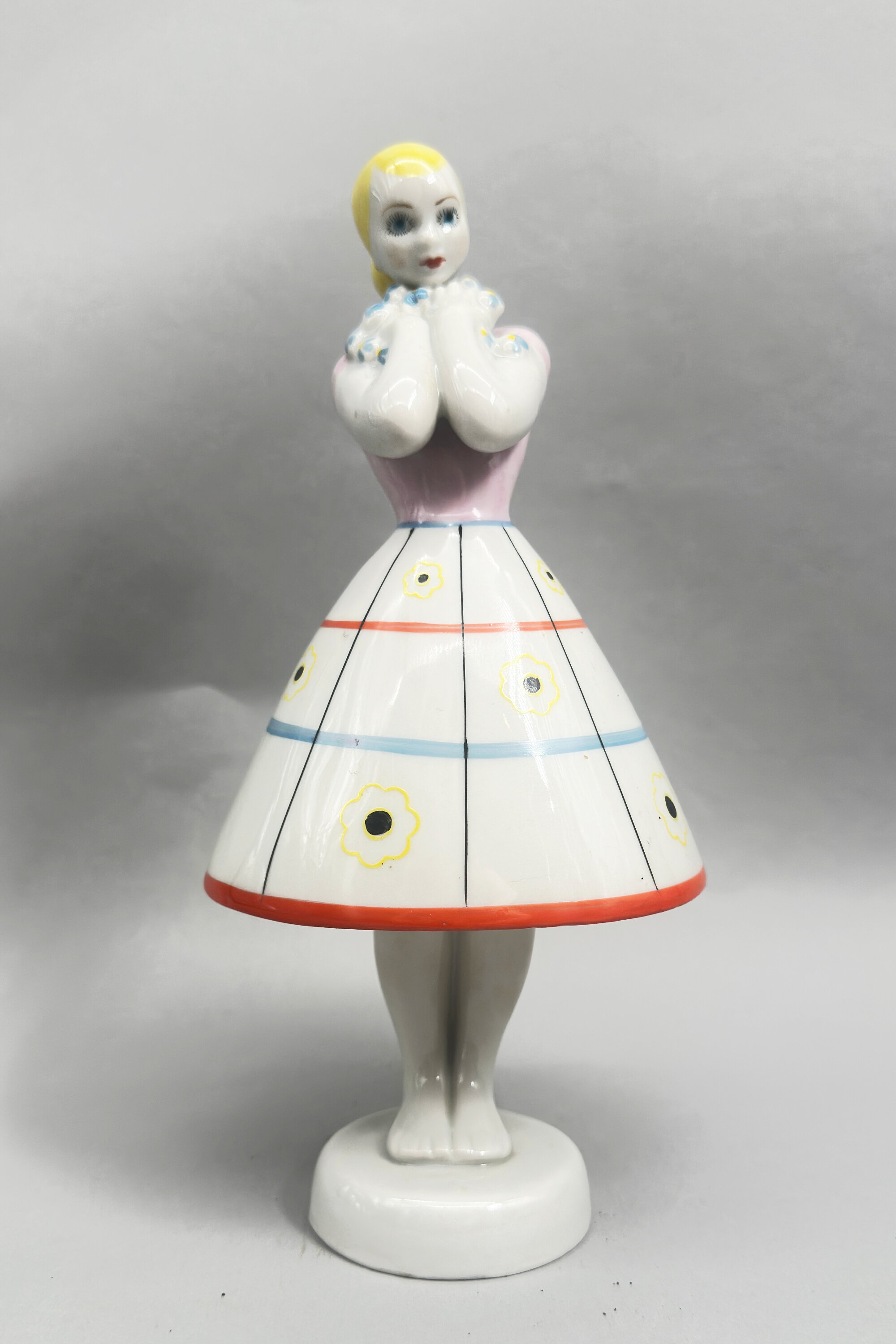
Figurine of a girl, Baranivka Ukraine, 1950s
Price: £55The Baranivka Porcelain Factory, one of Ukraine's oldest porcelain manufacturers, was founded in 1802-1804 by Mykhailo Mezer. Situated at Baranivka, at the time in Poland but now part of Ukraine, the factory was considerably assisted in its development by the discovery of rich clay deposits in the area. Production was continuous even during the Soviet era until the early twenty first century. Both the angular modelling and the abstract decoration of this piece point to a dating in the 1950s when production would have revived after the second world war and more contemporary styles adopted.
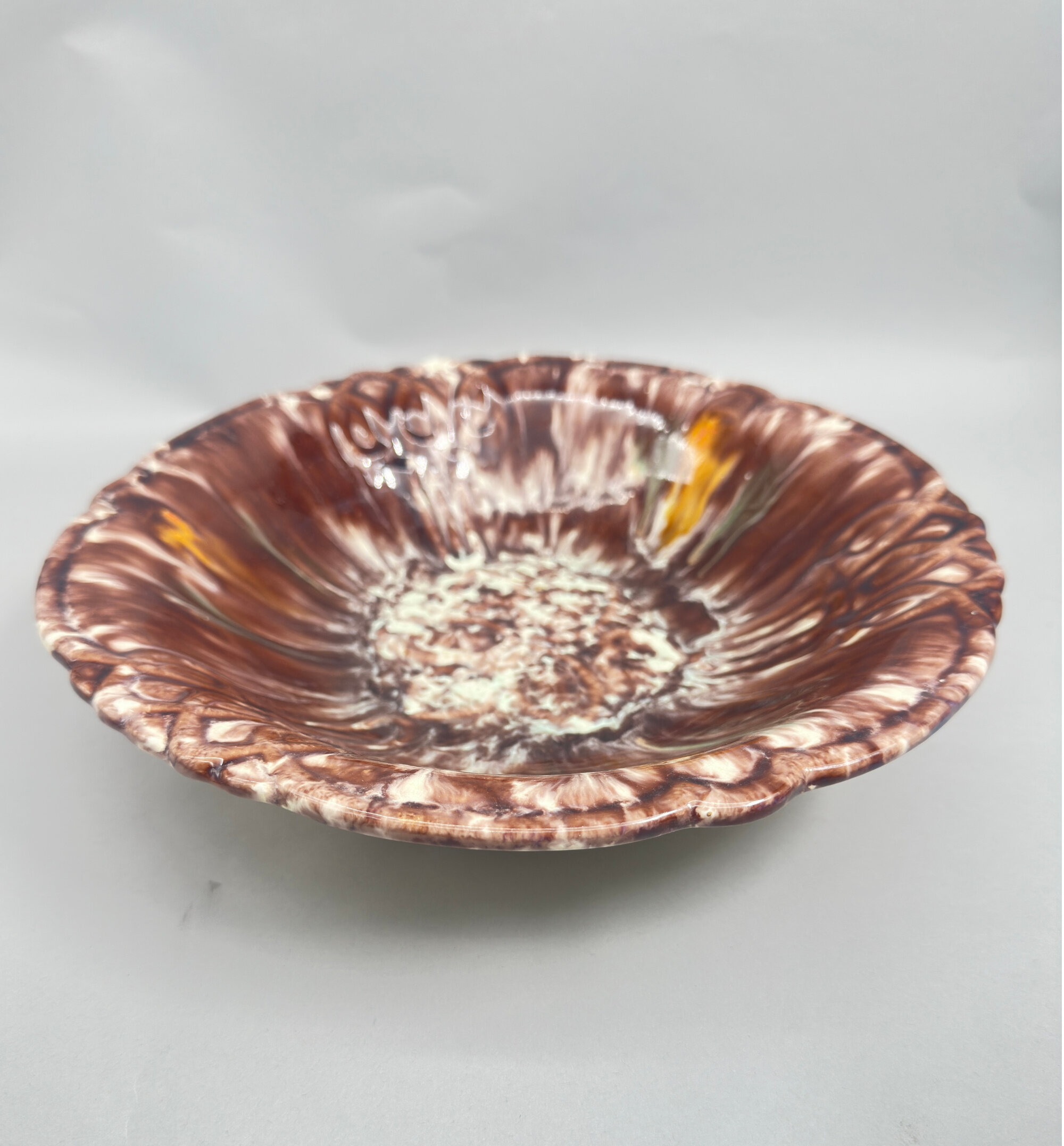
Majolica Footed Fruit Bowl, Germany, 1930s
Price: £55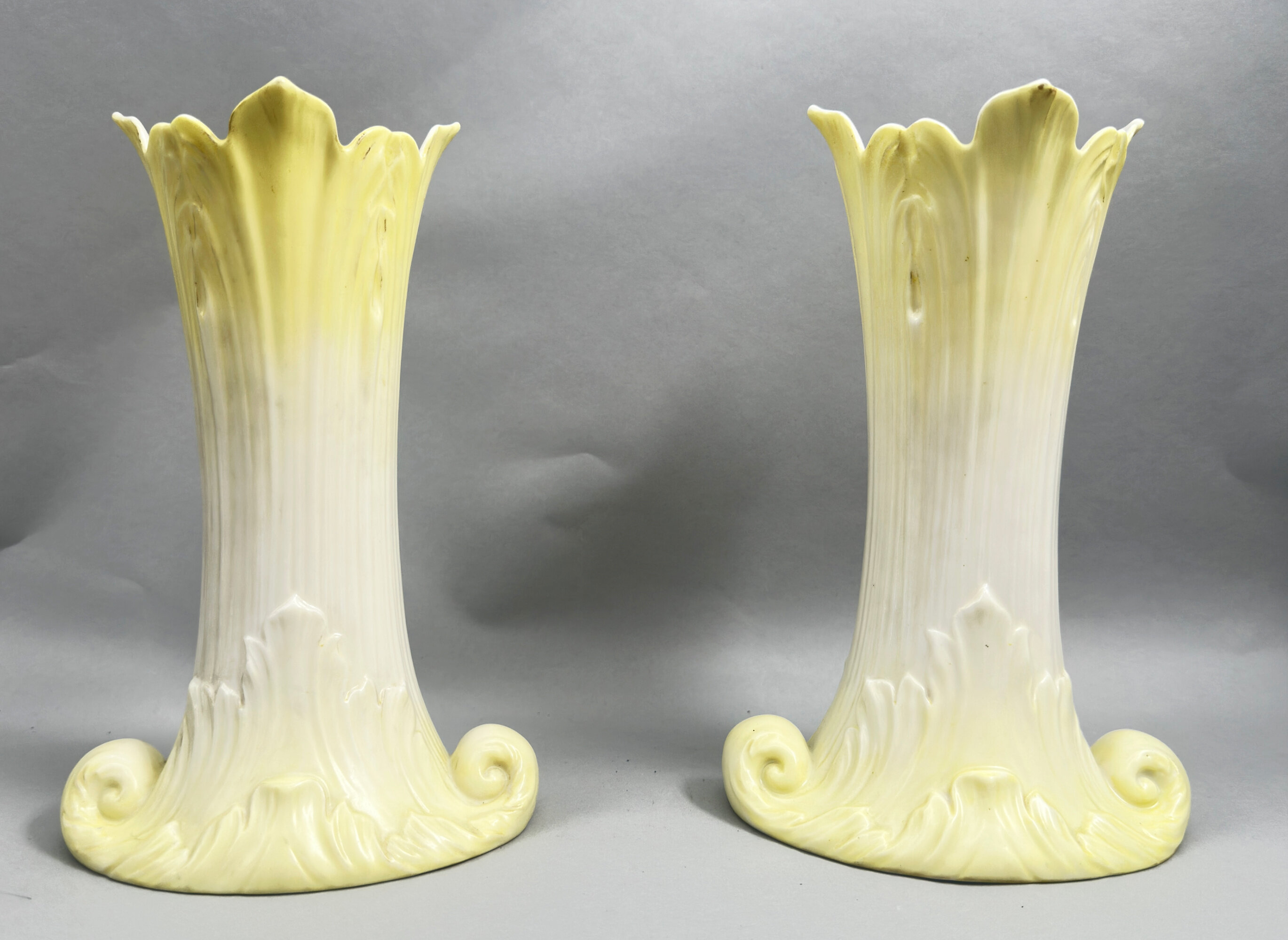
Pair of Royal Worcester Grainger and Co Vases, date mark for 1902
Price: £150The influence of the Art Nouveau movement, with its emphasis on organic and plant forms, is clearly seen here. The vases date to the early 1900s and were made by the ‘Grainger and Co’ branch of the celebrated Royal Worcester factory. The first porcelain factory at Worcester was set up in 1751 by John Wall (a doctor) and William Davis (an apothecary), along with 14 other businessmen. Fifty years later in 1801 Thomas Grainger (1783–1839) started a rival company ‘Grainger’s Worcester Porcelain’ and during the nineteenth century both companies traded successfully. However following the death of George Grainger, the son of Thomas Grainger, in 1889 the Grainger factory was sold to Royal Worcester who continued manufacture on its old rival firm’s St.Martin’s Gate site until finally closing the works in 1902. Ivory style porcelains were one of the specialities of this brief manufacturing period and the date mark ‘L’ which appears on these vases is for the year 1902, just before the two concerns were completely merged.
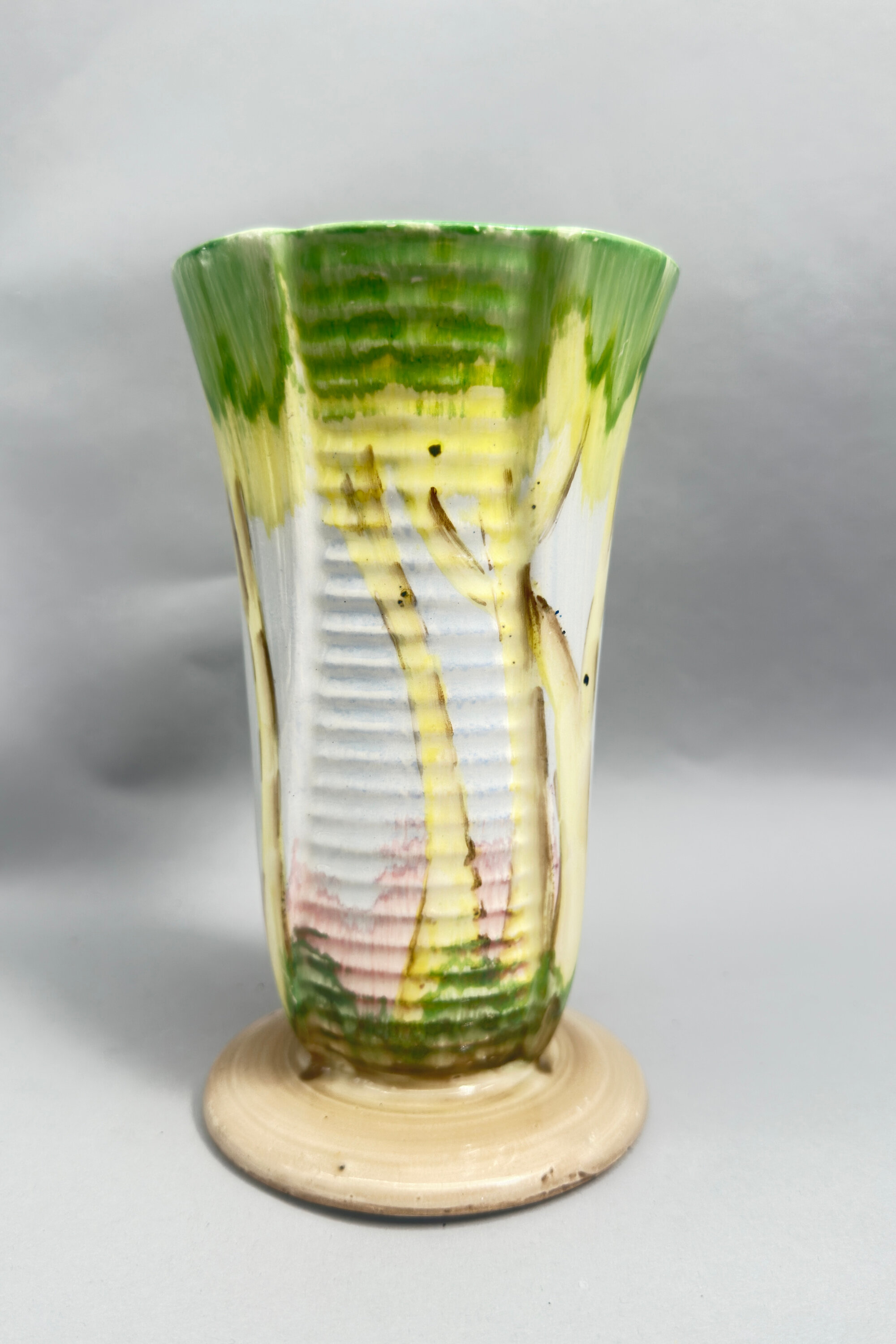
Art Deco style beaker form Vase, probably Beswick, mid C20th
Price: £35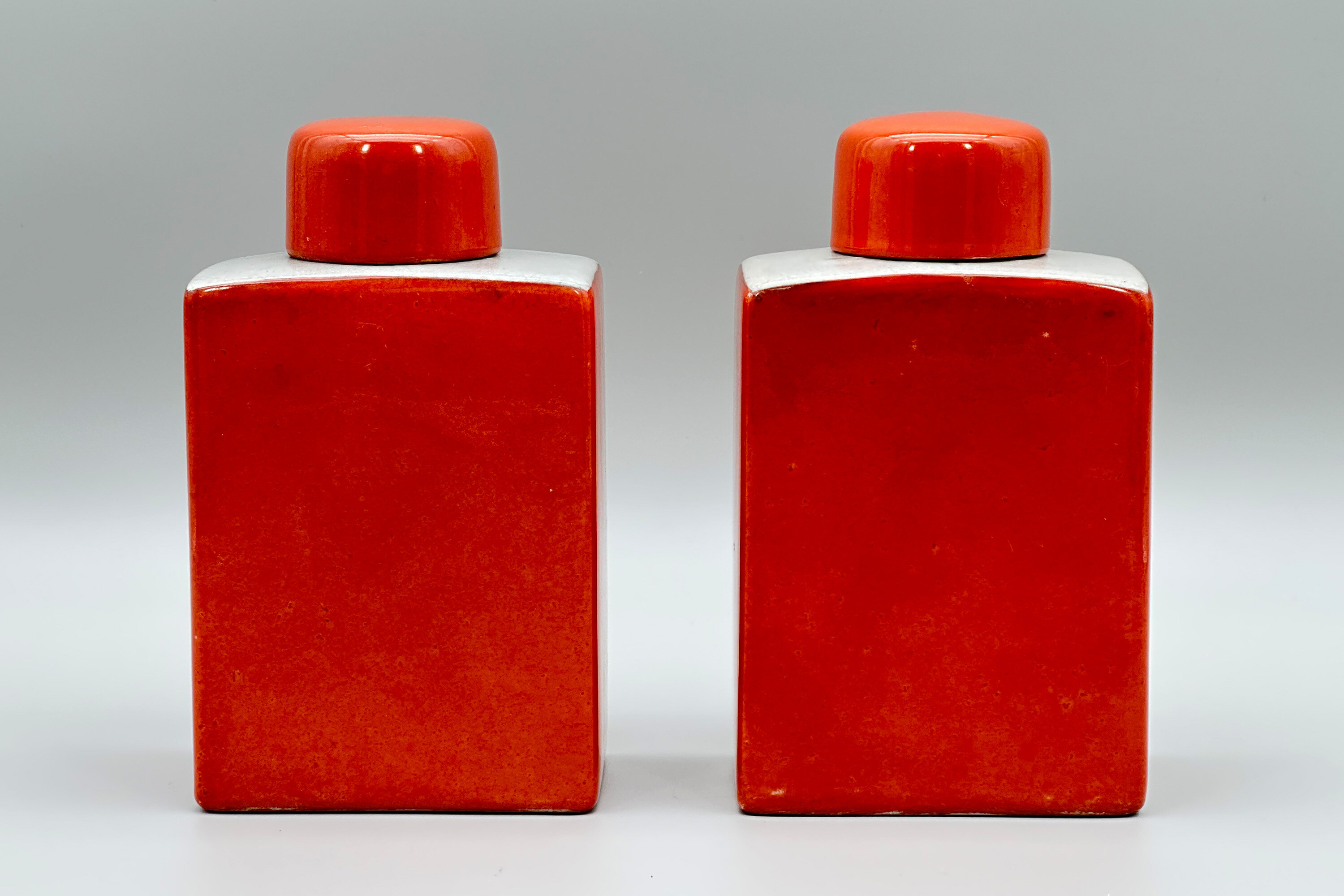
Pair of Orange Glazed Flasks and Covers, Fabienne Jouvin Paris, C20th
Price: £150The French designer Fabienne Jouvin (see image 9) graduated from the superior school of applied arts Duperré in 1985. Since then, she has travelled the world collecting designs for pieces sold and exhibited under her name internationally, with a studio based in Paris. On her website, she writes “From my travels - from Tokyo to The Habana, from the streets of Paris to the sea bed of The Maldives - I bring back sketchbooks, pads of notes, drawings and collages: hispanic or contempory architectures, faces reminding those of Piero Della Francesca, enigmatic objects non identified... These spontaneous sketchbooks give rise to unique pieces and editions painting, textile, porcelain, cloisonné...”. Her first exhibition was in 1989 and in 1996 she began an association with the firm ‘Asiatides’ allowing her to create pieces made in China and Thailand and utilising their designs and techniques.
This pair of flasks, possibly intended as tea caddies, are typical of her ability to give a ‘twist’ to the pieces from which she draws her inspiration. The shape is Chinese from the seventeenth century (see image 10), while the iron red colour is found on Chinese pieces two hundred or more years later. Combining this with a white ‘crackle glaze’, also well known from Chinese ceramics, was Jouvin’s own idea completing the mix of ancient and modern. Marked as from the Asiatides range with the stylised ‘A’, pieces like these are no longer available currently implying that they were probably made early on in her association with the firm and now have a uniqueness of their own.

Pair of Lovatt and Lovatt Earthenware Vases, early C20th
Price: £95The Langley Mill Pottery was located in Langley Mill, Derbyshire on the Derbyshire – Nottinghamshire border. From its establishment in 1865 to its final closure in 1982, it went through five distinct periods of ownership, producing a wide range of stoneware ranging from utilitarian items and to high quality art pottery. This pair of vases dates from the third company that traded there, Lovatt and Lovatt. The Lovatt family had entered into partnership with the owner of the founding business at Langley Mill, James Calvert. From 1895 the business was in sole control of the Lovatt family and traded as ‘Lovatt and Lovatt’ until 1935. The early years of the twentieth century proved to be something of a zenith for them and a wide range of art pottery pieces were made which enjoyed great popularity. Production techniques were streamlined without a reduction in quality and in 1905, leadless glazes were introduced. These are proudly announced on the base of this pair of vases which are a fine example of the Lovatt and Lovatt style and probably date to 1913, indicated by the impressed numbers for that year.
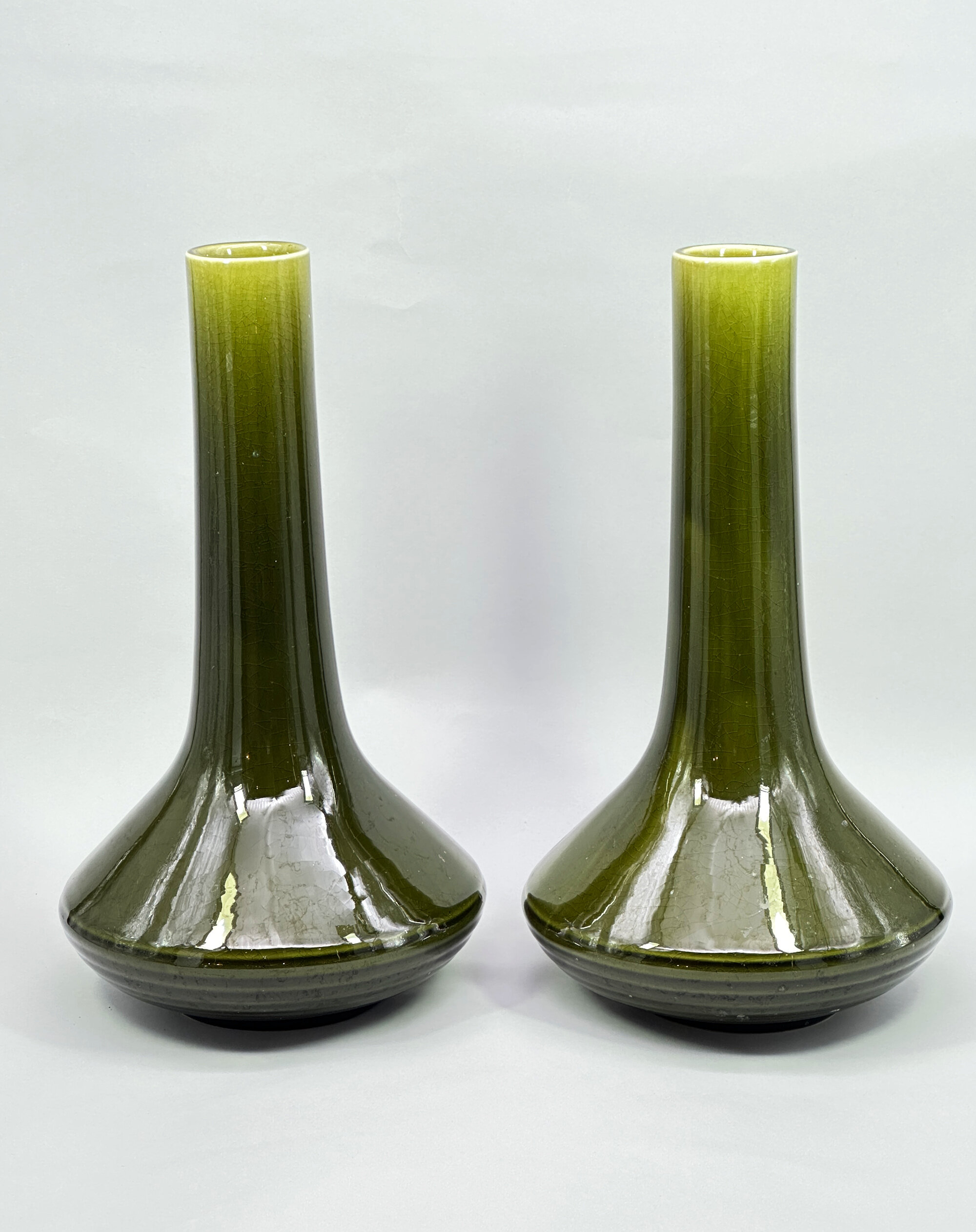
Pair of Green Glazed Bottle Vases, possibly French C20th
Price: £180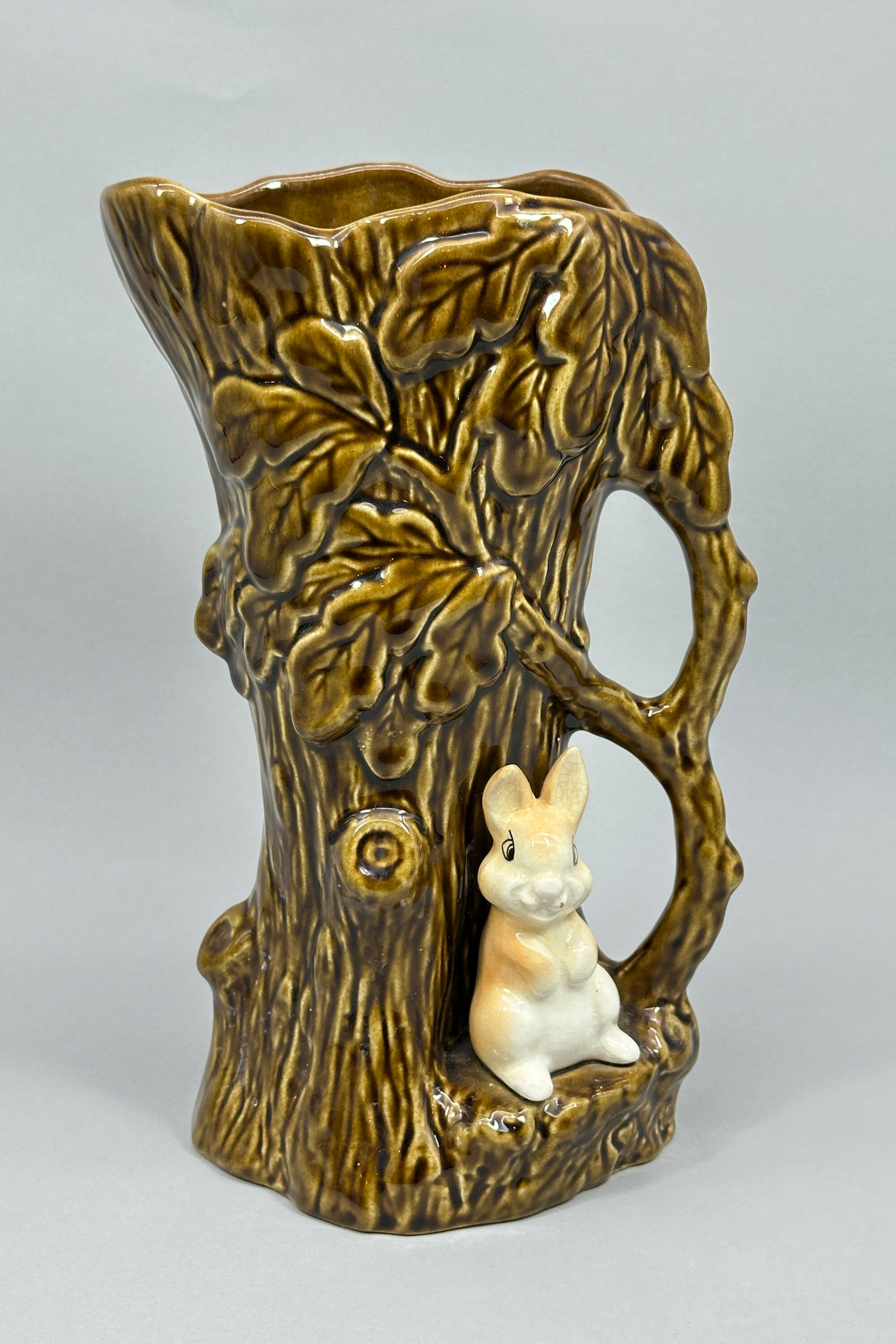
Sylvac woodland range Rabbit and Tree Jug, 1950s
Price: £35‘SylvaC’ (the name was written with a capital ‘C’ after registration of the trademark in 1938) was a trade name of Shaw and Copestake, a company formed by Mr. William Shaw and a Mr. Copestake around 1900. Mr. Copestake sold his shares to a Mr. Richard Hull after about six months of business and this partnership continued until Mr. Hull’s death in 1935. He was succeeded by his son, Mr. Richard Hull junior. In the following year, the business became a limited company. Various mergers and acquisitions followed and in the 1950s new premises were built and production expanded considerably continuing until the early 1980s when changing markets and increased competition forced the company into liquidation.
Sylvac were famous for imaginative glazed wares, particularly animals, and this jug is a typical and pleasing example of their work.
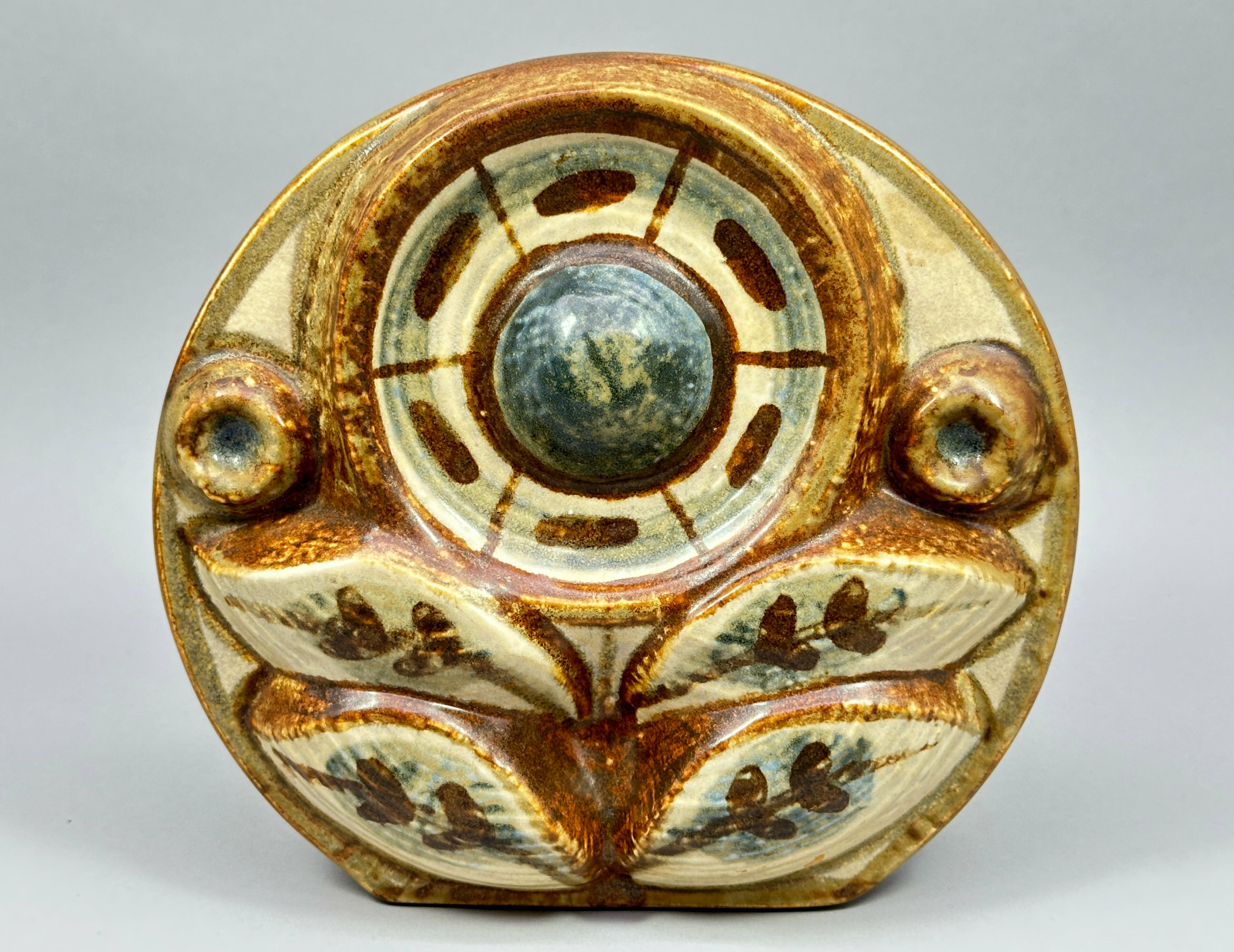
Wall Vase, designed by Noomi Backhausen, Søholm Stentøj, Denmark, late C20th
Price: £95The company Søholm Stentøj was founded by Herman Sonne Wolffsen and Edvard Christian Sonne in 1835 at Rønne, the principal town of Bornholm, a Danish island off the south coast of Sweden. One of the most respected of the Danish potteries it continued producing a wide range of ceramics until the firm closed in 1996. Noomi Backhausen was a designer for Søholm from 1966 to 1990 and set up her own pottery in Rønne in 1996 after the closure of her old employers. This wall vase is a typical example of her abstract organic designs and would be a worthy addition to a collection of twentieth century Danish design.

Kiralpo ware Dressing Table Set, marked, 1930s
Price: £35Kiralpo ware was one of the trade names used by Kirkland and Co, earthenware and ceramic manufacturers based at the Albion Pottery, Etruria, Stoke-on-Trent, England who traded from 1891 to 1938 when the business was bought and renamed by Mr A.E.Gray. The format of the mark gives a dating between 1928 and 1938 with ‘E’ standing for Etruria. Kirkland and Co made various modest but colourful decorative items to furnish the home. In a 1907 guide they are described as ‘general earthenware, fancy goods, and majolica manufacturers’. Their designs were not sophisticated but obviously had a popular appeal and this set with its bold transfer decoration of birds set within a rather vivid pink border is typical of their work.

Japanese Kutani Part Tea Service circa 1920
Price: £75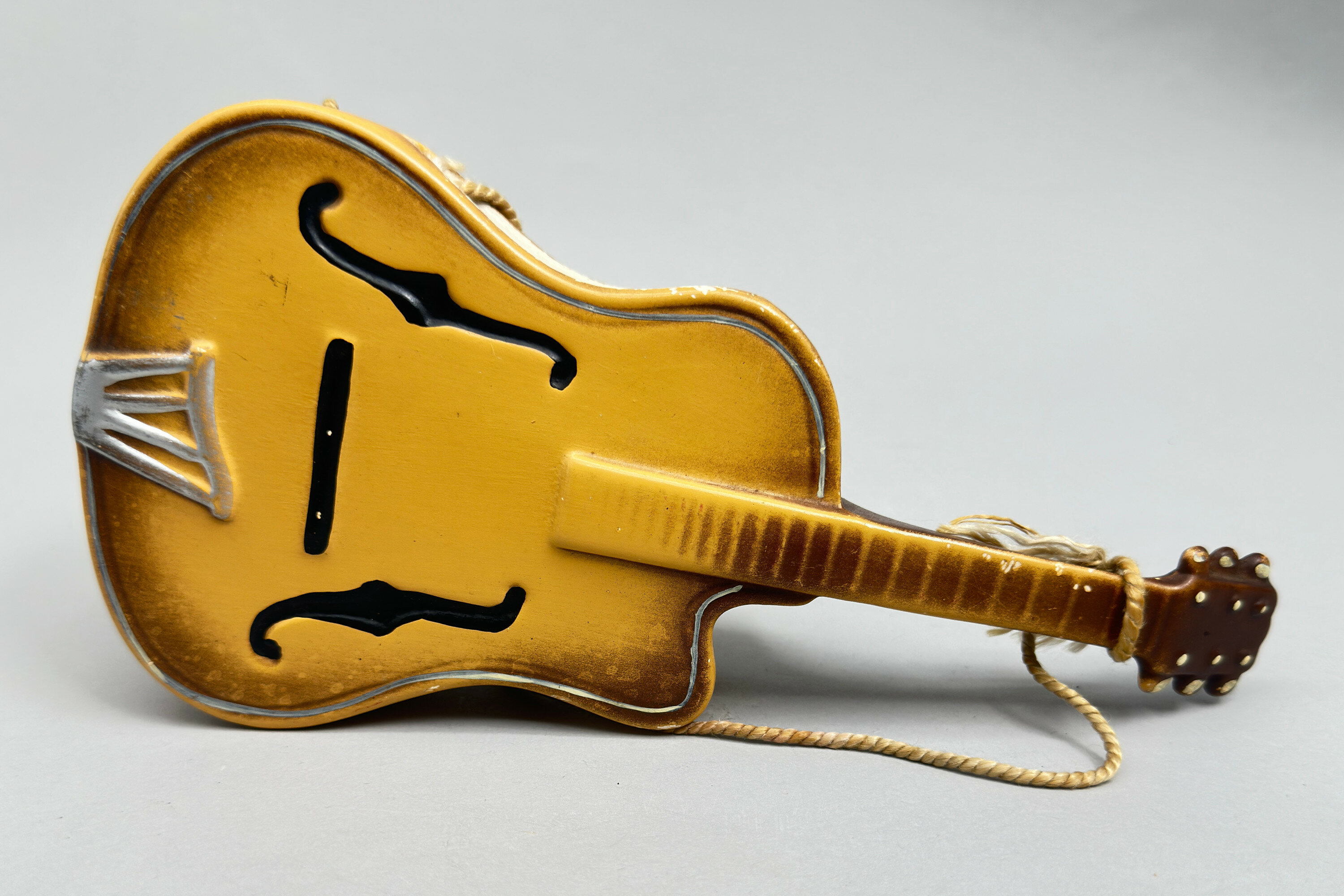
Novelty ceramic Wall Vase in the form of a Gretsch Guitar, English, 1950s
Price: £25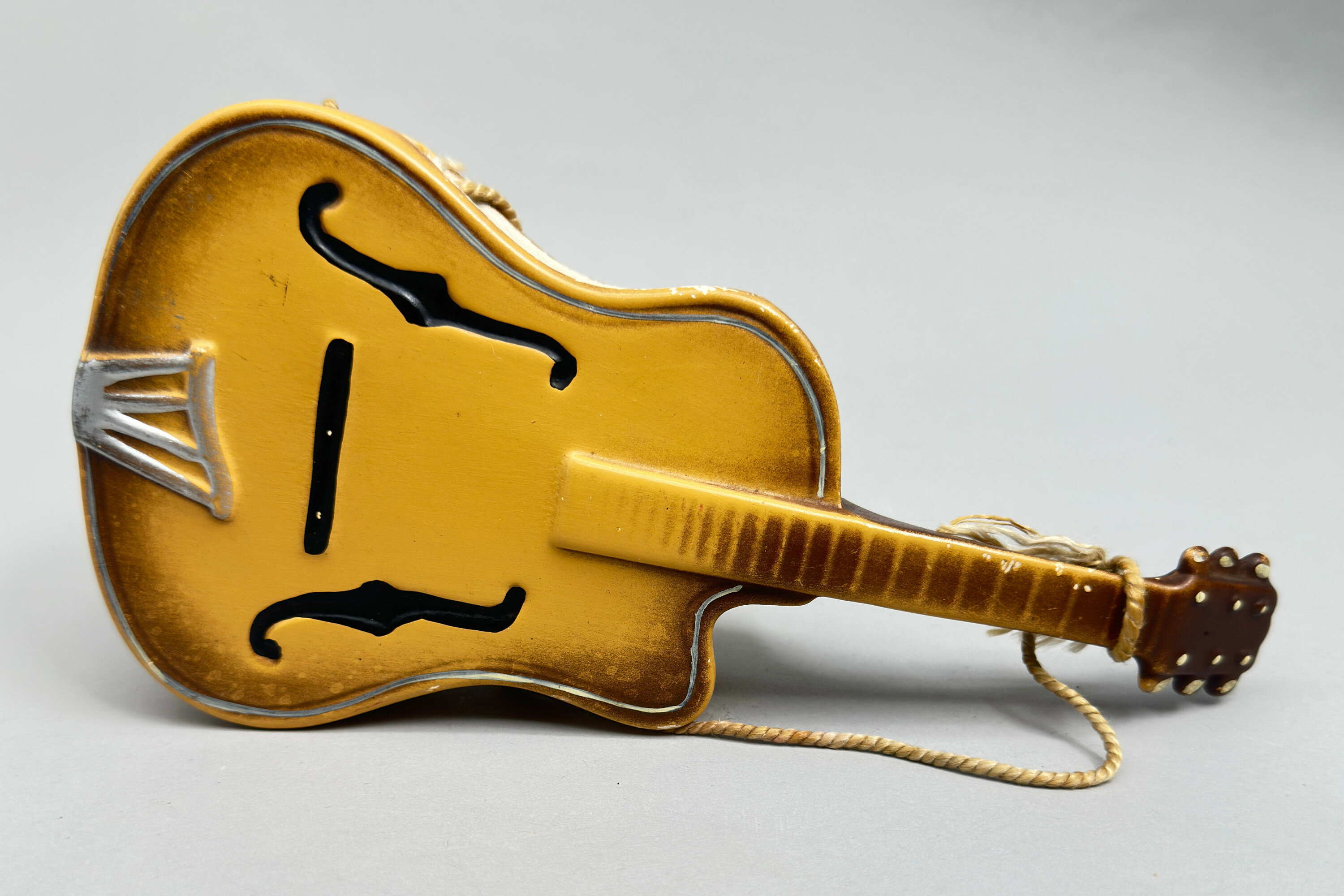
Novelty ceramic Wall Vase in the form of a Gretsch Guitar, English, 1950s
Price: £25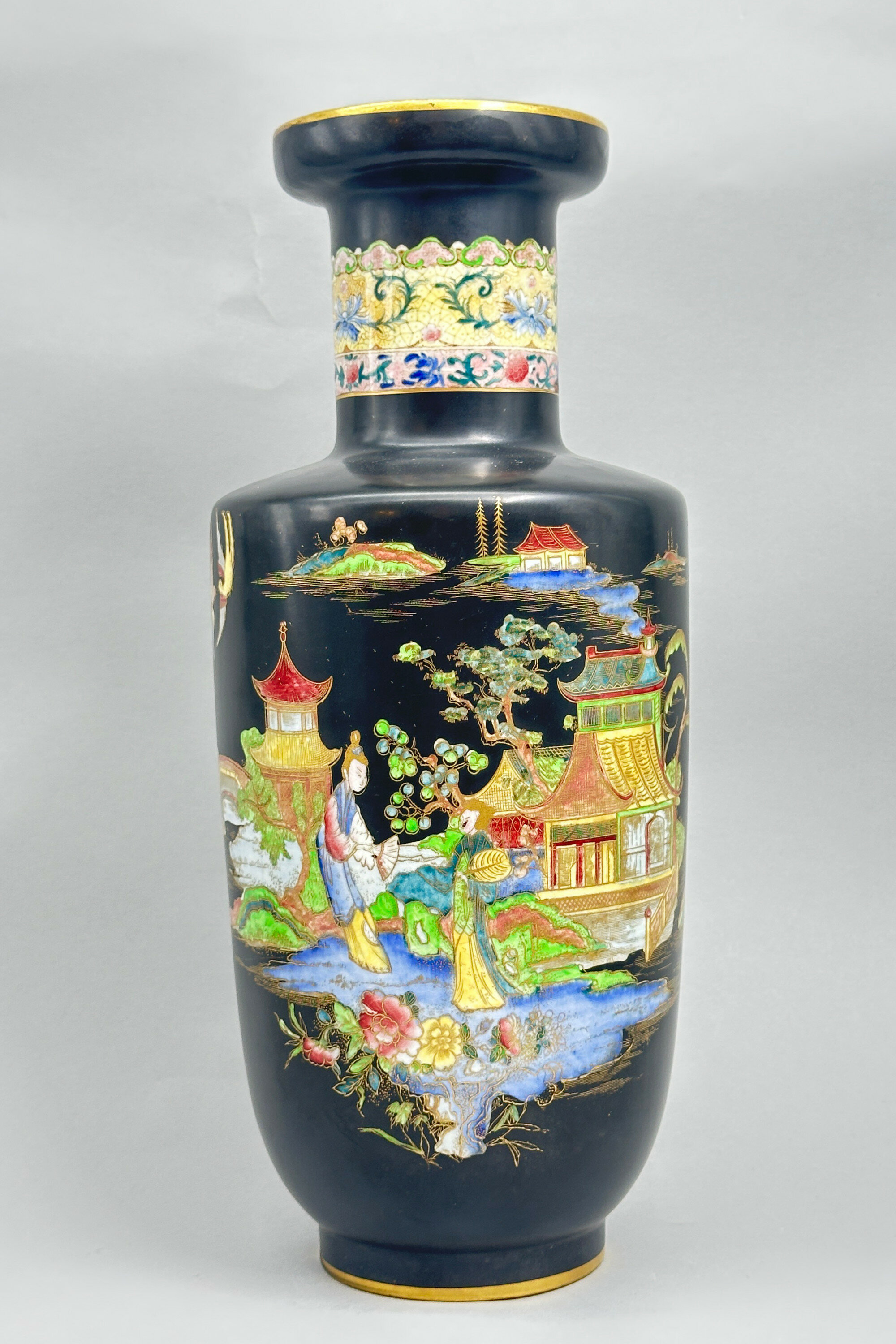
Mikado Carlton Ware Vase, 1920s
Price: £45Carlton Ware was the trade mark used by the pottery manufacturer Wiltshaw and Robinson, whose premises were located in Stoke on Trent, four years after the firm’s establishment in 1890. The firm mostly concentrated on decorative giftware and new methods of production introduced in the 1920s put it at the forefront of the earliest Art Deco pottery pieces produced, firstly with designs originating from Tutankhamun’s tomb and then with pieces with an Oriental influence of which this vase, in shape not often seen in this design, is a prime example.
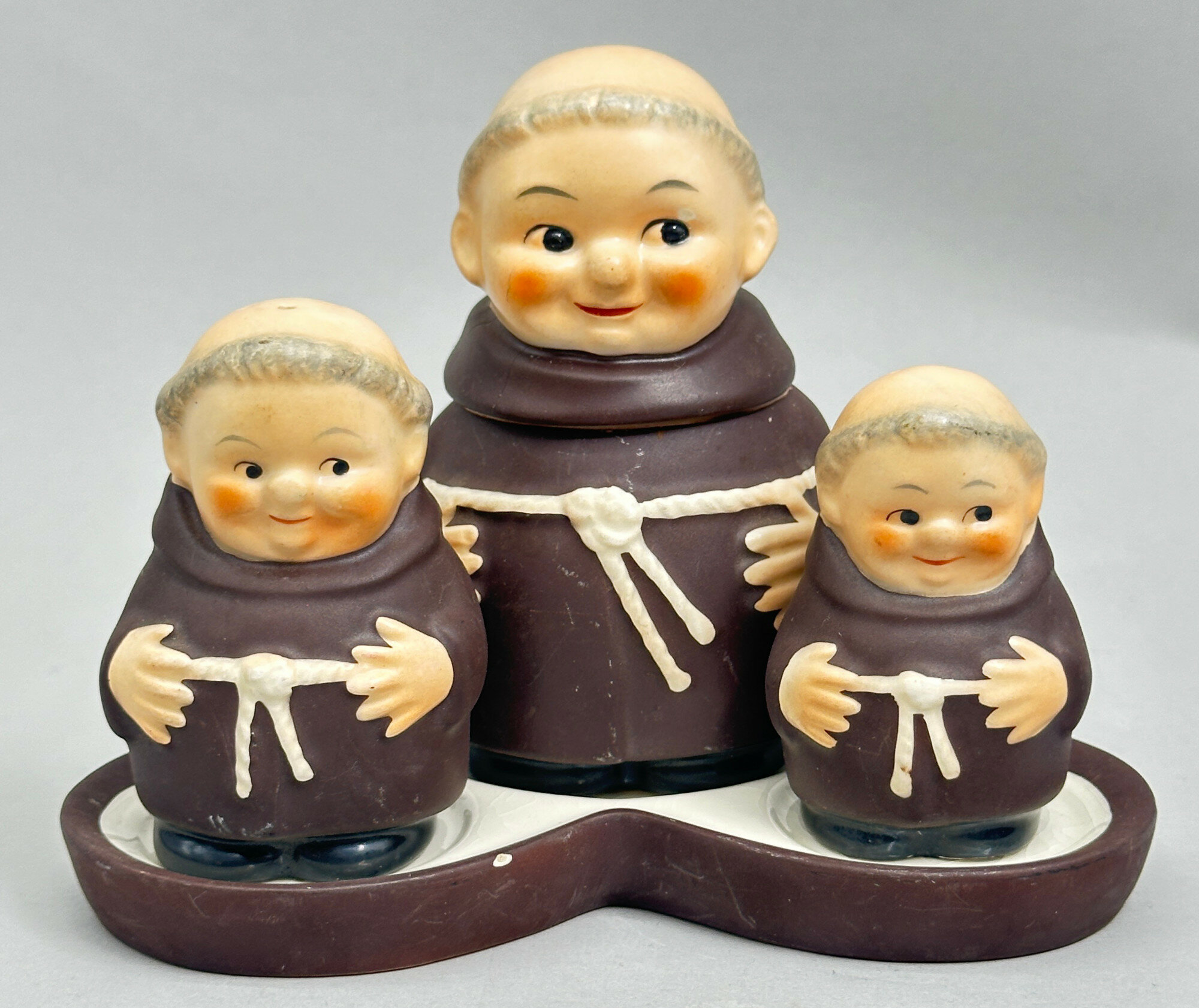
Cruet set in the form of three Friar Tuck Monks on a Tray, Hummel, West Germany, 1960s
Price: £55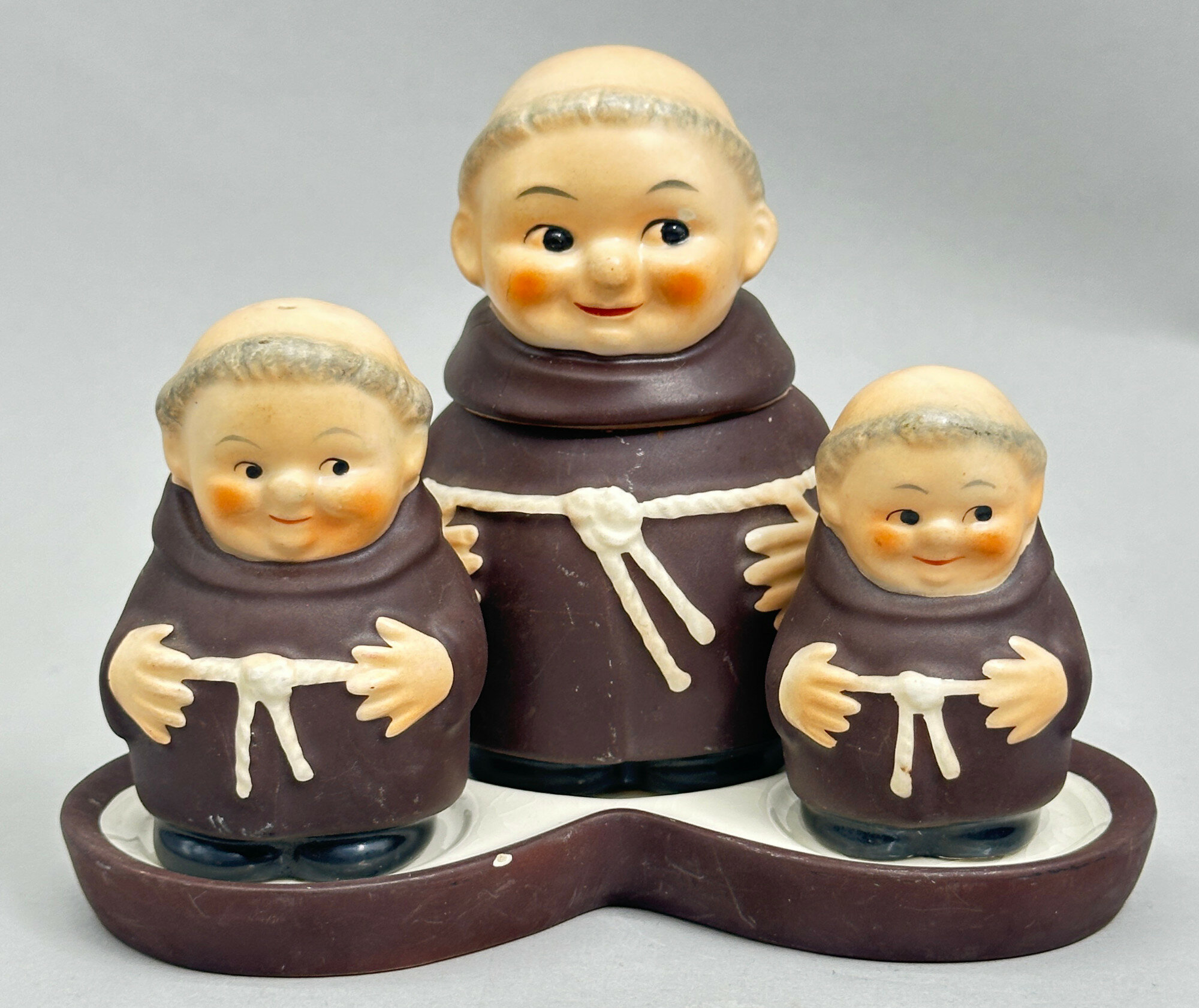
Cruet set in the form of three Friar Tuck Monks on a Tray, Hummel, West Germany, 1960s
Price: £55
Falcon Ware Jardiniere decorated Mallard Duck and Foliage, 1930s
Price: £65Falcon Ware was the trade name for pieces produced by Thomas Lawrence, later Thomas Lawrence (Longton) Ltd, a business founded by Thomas Lawrence in 1885 which moved to the Falcon works, Longton, in 1895. In the same year he took his nephew, John Grundy into partnership and around 1920 Grundy became the Managing Director. Thomas Lawrence died in April 1932 and John Grundy became the sole proprietor until his death in 1938 when the business was sold to Grundy's son-in-law Mr Richard Hull (jnr) and Mr. E.J. Dennis and the name was changed to 'Thomas Lawrence (Longton) Limited'. At the same time the firm merged with Shaw and Copestake Ltd of which Richard Hull was a Director but the two businesses still operated independently until 1962 when the Thomas Lawrence business was fully subsumed by its partner with the ‘Falcon’ name ceasing to be used two years later in 1964.
Falcon Ware was known for colourful and decorative designs often with naturalistic themes. This jardiniere is an excellent and unusual example. The cipher ‘LG’, for Lawrence and Grundy, which is not so often found, implies a dating to the 1930s which corresponds with the general style of the piece with its hint of Art Deco associations.

Commemorative Ware Silver Jubilee Plate, James Kent Ltd, England, 1935
Price: £35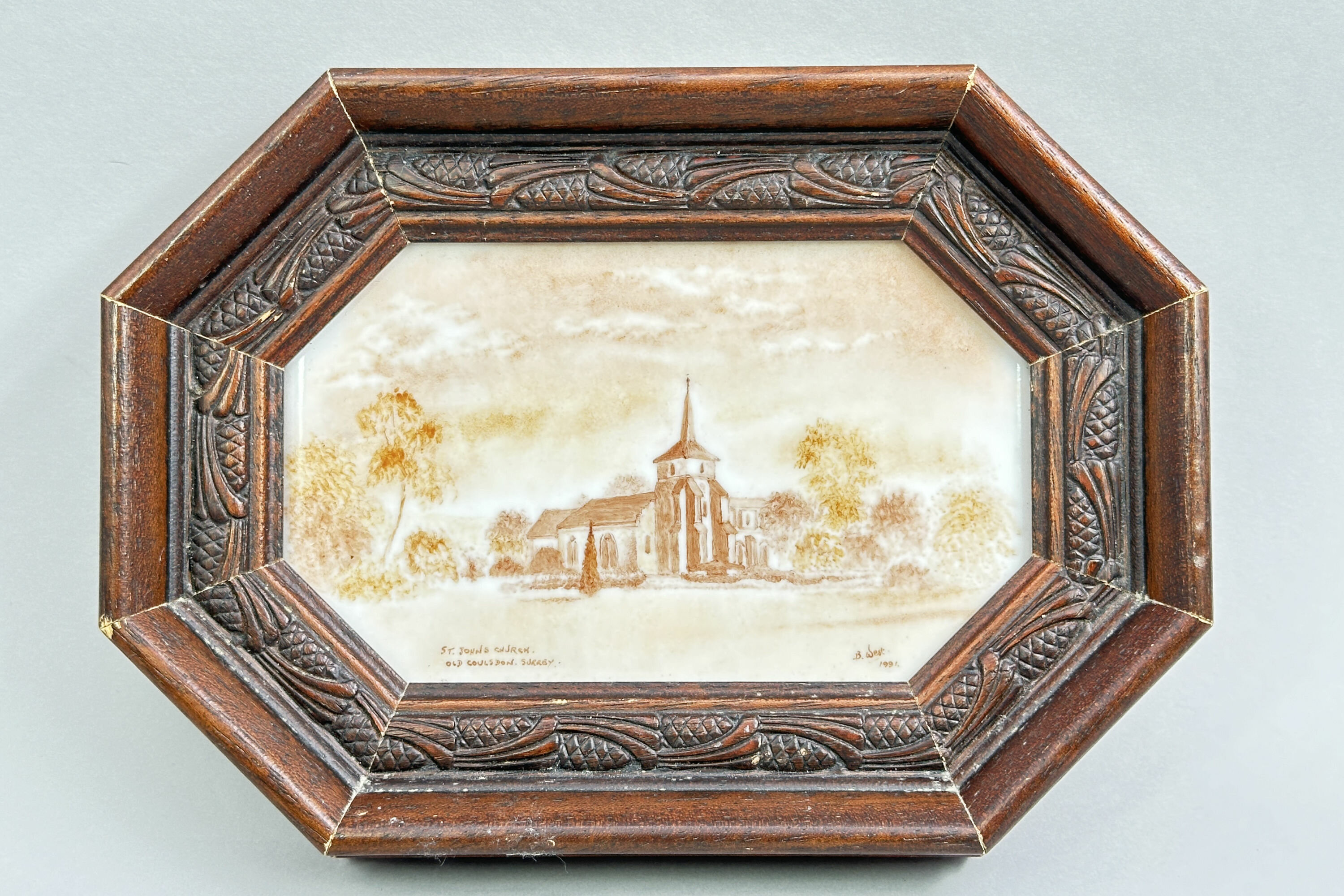
Framed Ceramic Plaque depicting St John’s Church, Old Coulsdon, late C20th
Price: £25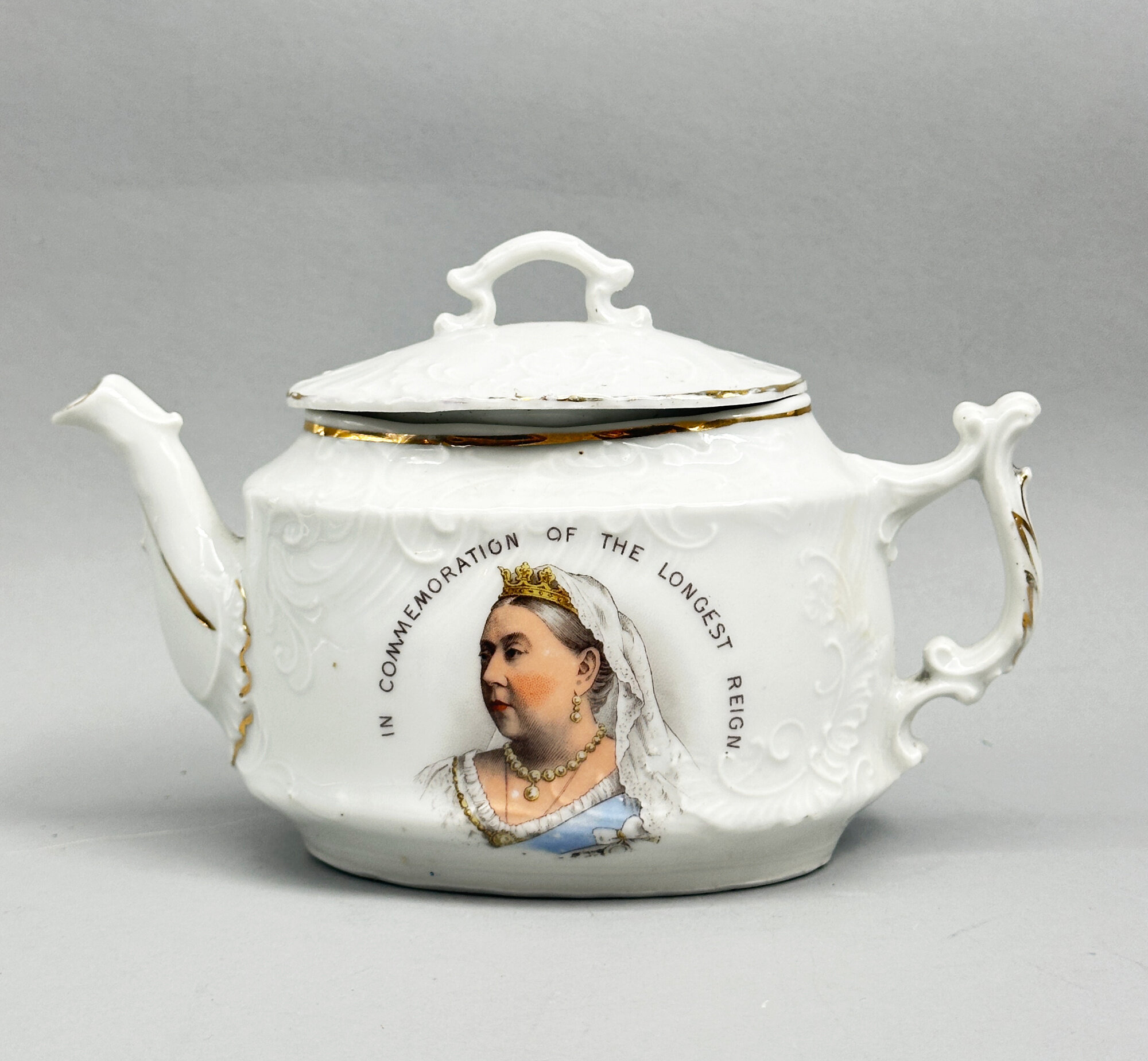
Reproduction Queen Victoria Diamond Jubilee Teapot, Modern
Price: £35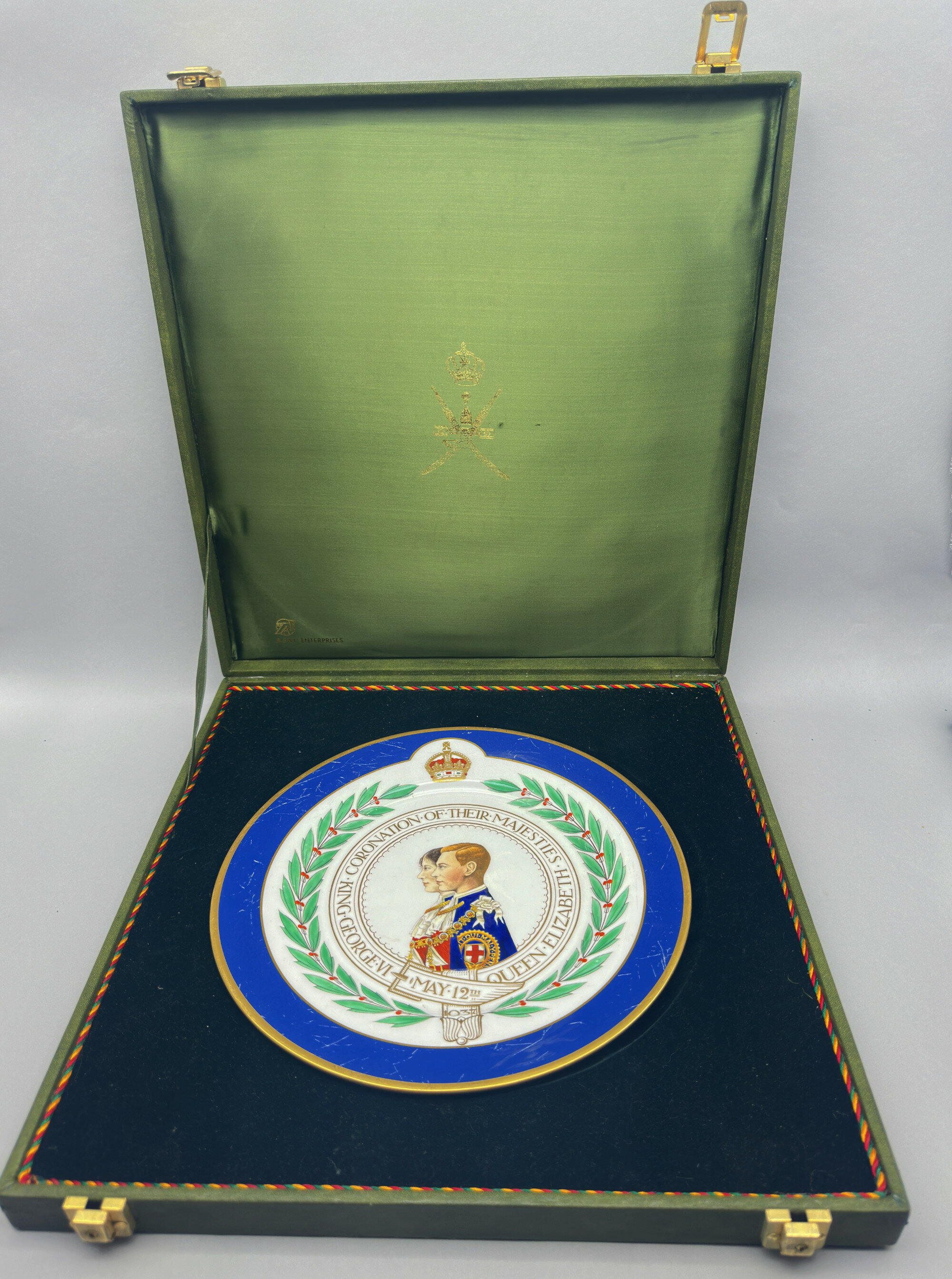
Mintons Coronation Plate, King George VI and Queen Elizabeth 1937, boxed
Price: £25
Wedgwood Calendar Plate, 80th Birthday of Queen Elizabeth II, 2006
Price: £10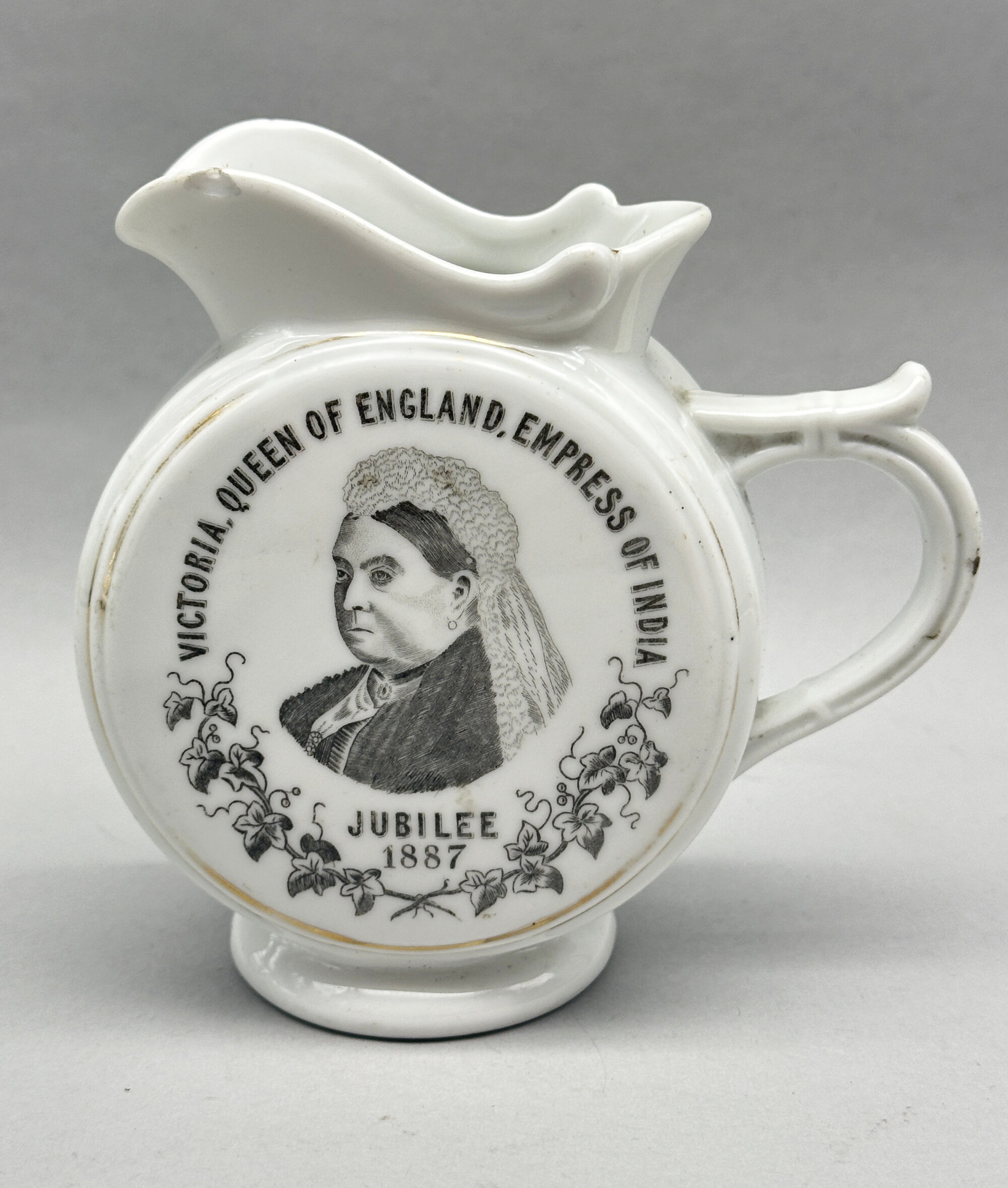
Queen Victoria Golden Jubilee Jug, 1887
Price: £10
VE Day, 50th Anniversary Commemorative Mug, 1995
Price: £10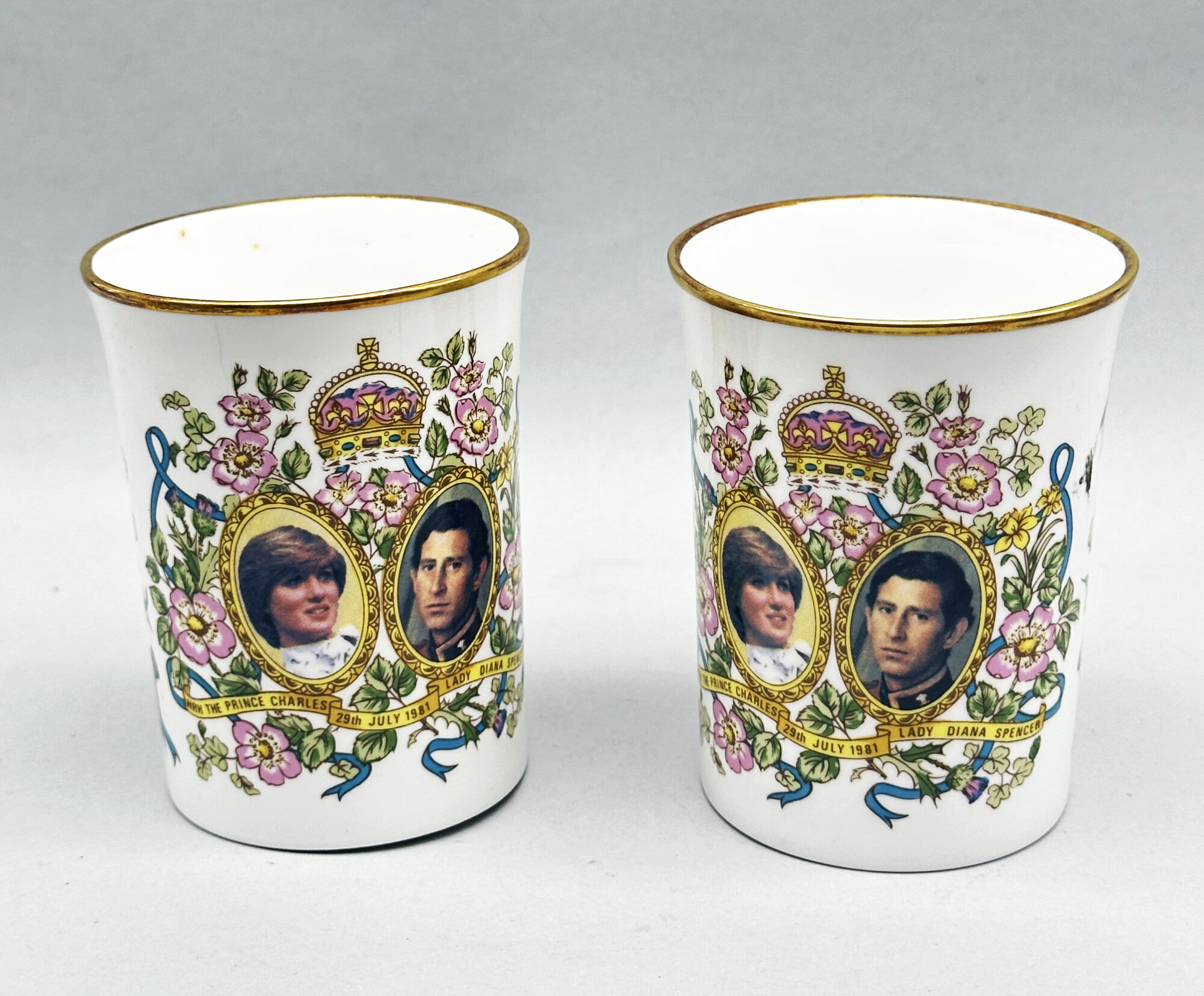
Two Beakers : Wedding of the Prince Charles and Lady Diana Spencer, 1981
Price: £15
Two Wood Boxes : Marriage of Charles and Diana, Birth of Prince William, late C20th
Price: £15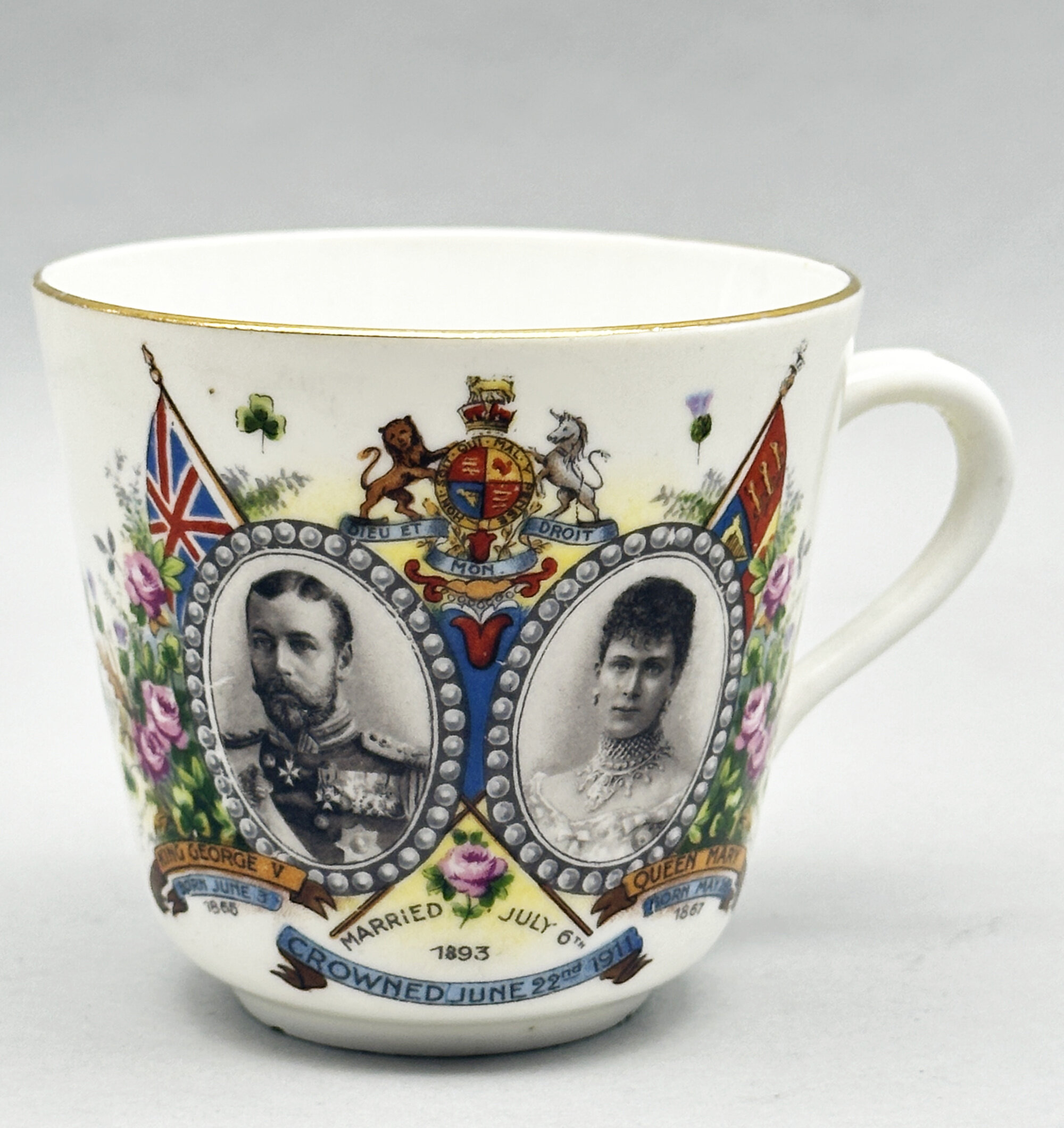
Cup : Marriage and Coronation of King George V and Queen Mary, 1911
Price: £10Production of this piece was presumably contemporary with the coronation in 1911 and many similar pieces were made by other factories at the time, more often in a straight sided mug shape. The form here suggests that there might have been an original saucer but none seem to have survived.

Porcelain Mug : Buckingham Palace 1997
Price: £10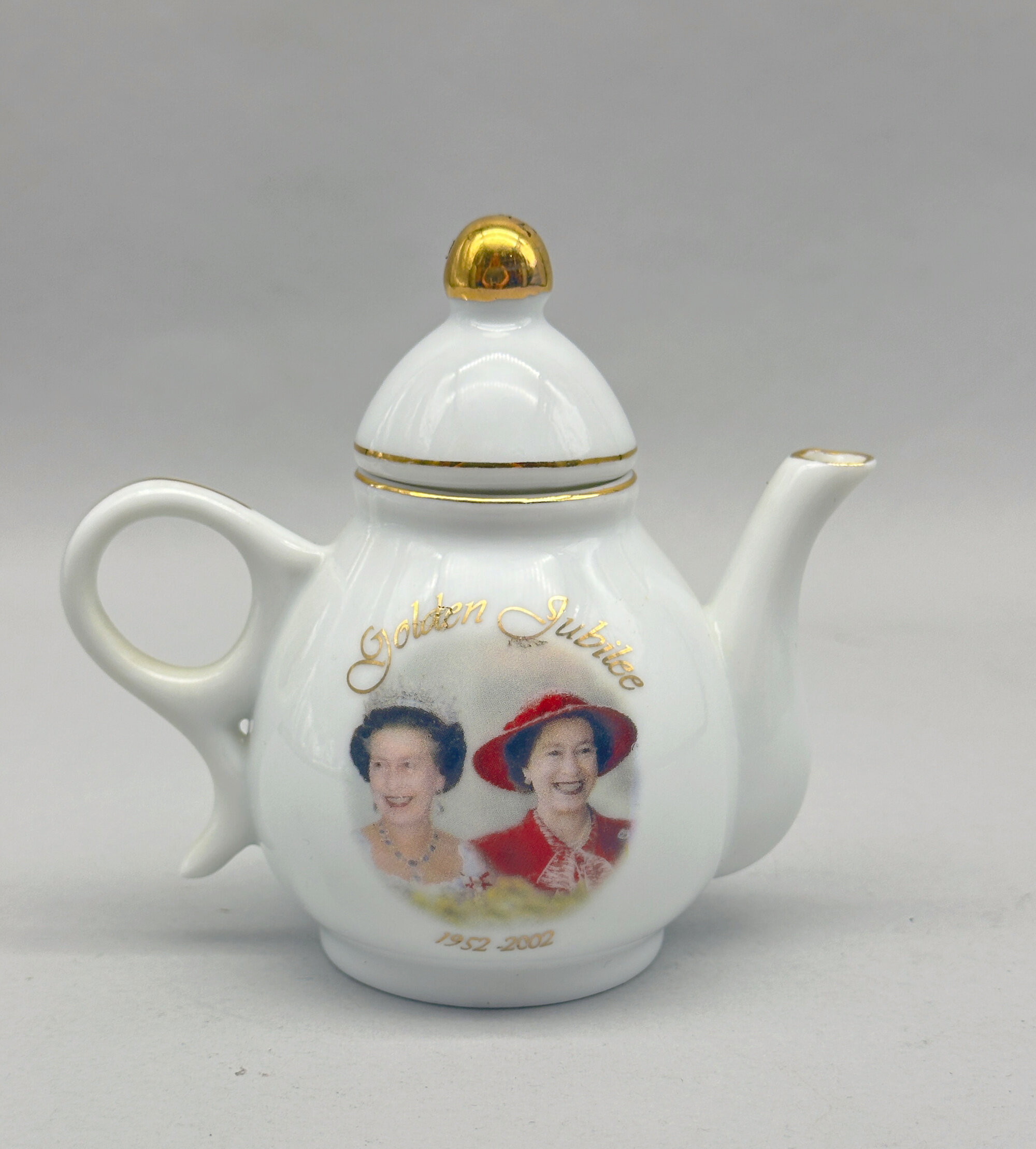
Teapot and Cover : Golden Jubilee Queen Elizabeth II, 2002
Price: £10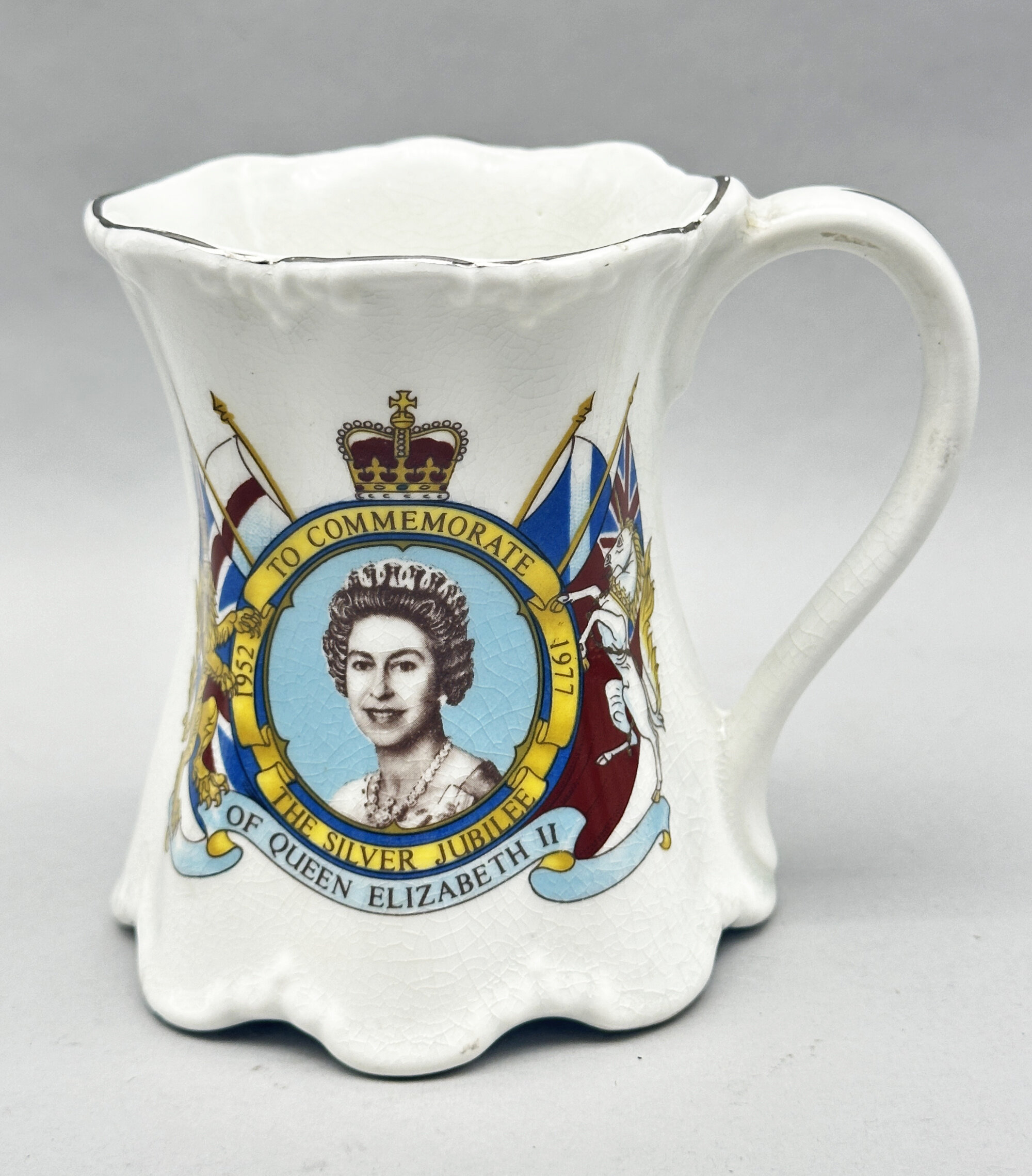
Queen Elizabeth II Silver Jubilee China Mug, 1977
Price: £10
Cup : the Silver Wedding Anniversary of Queen Elizabeth II and Prince Philip in 1972
Price: £25The Paragon China Company, formerly the Star China Company (see Lot XX), produced high quality gift items from 1920 to 1971, at first independently and then in alliance with other companies, finally being absorbed by Royal Doulton in 1972 who kept the ‘Paragon’ name until 1991. Commemorative wares were a speciality and this cup is a fine and typical example.
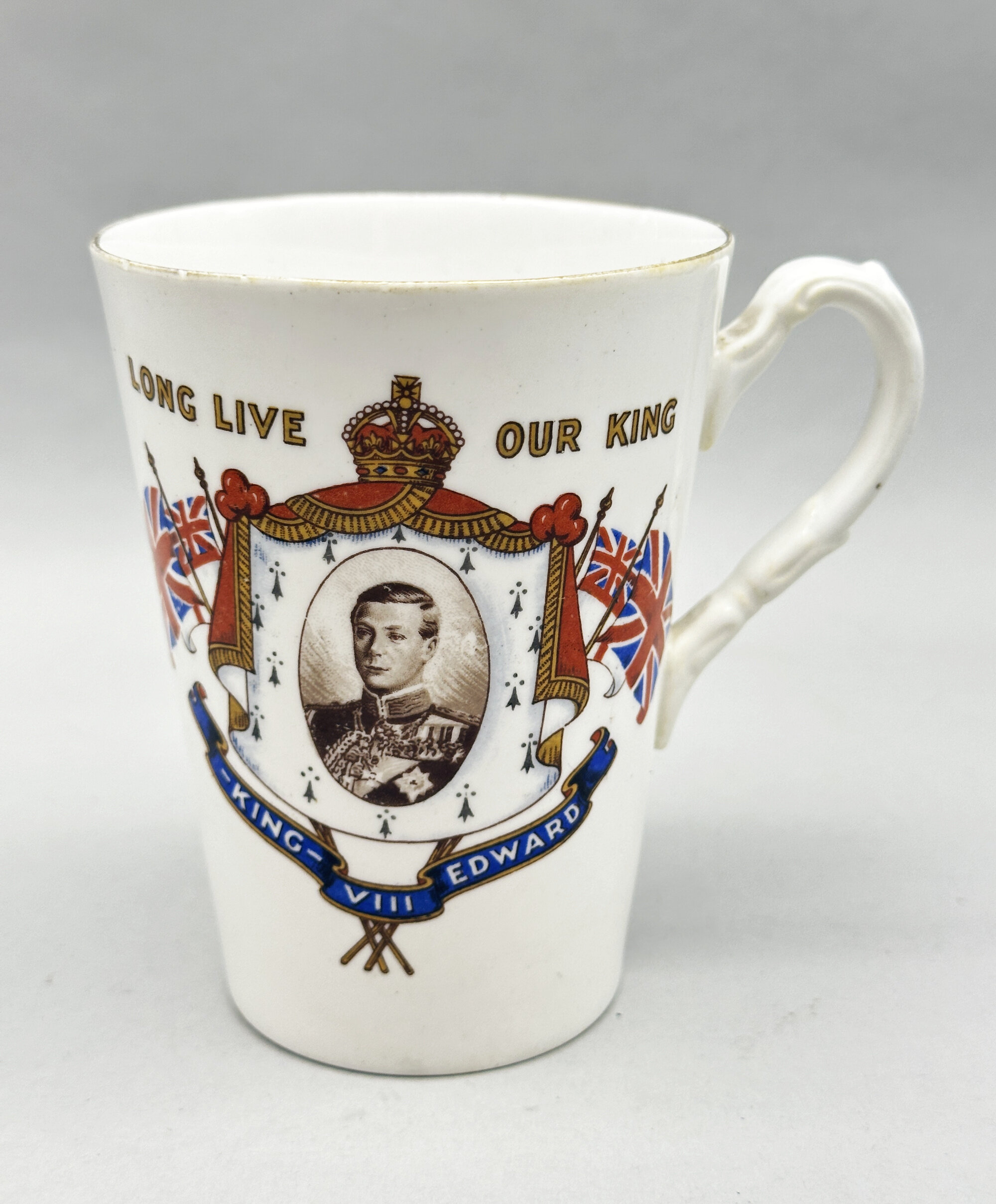
Mug Commemorating the Coronation of Edward VIII in 1937
Price: £25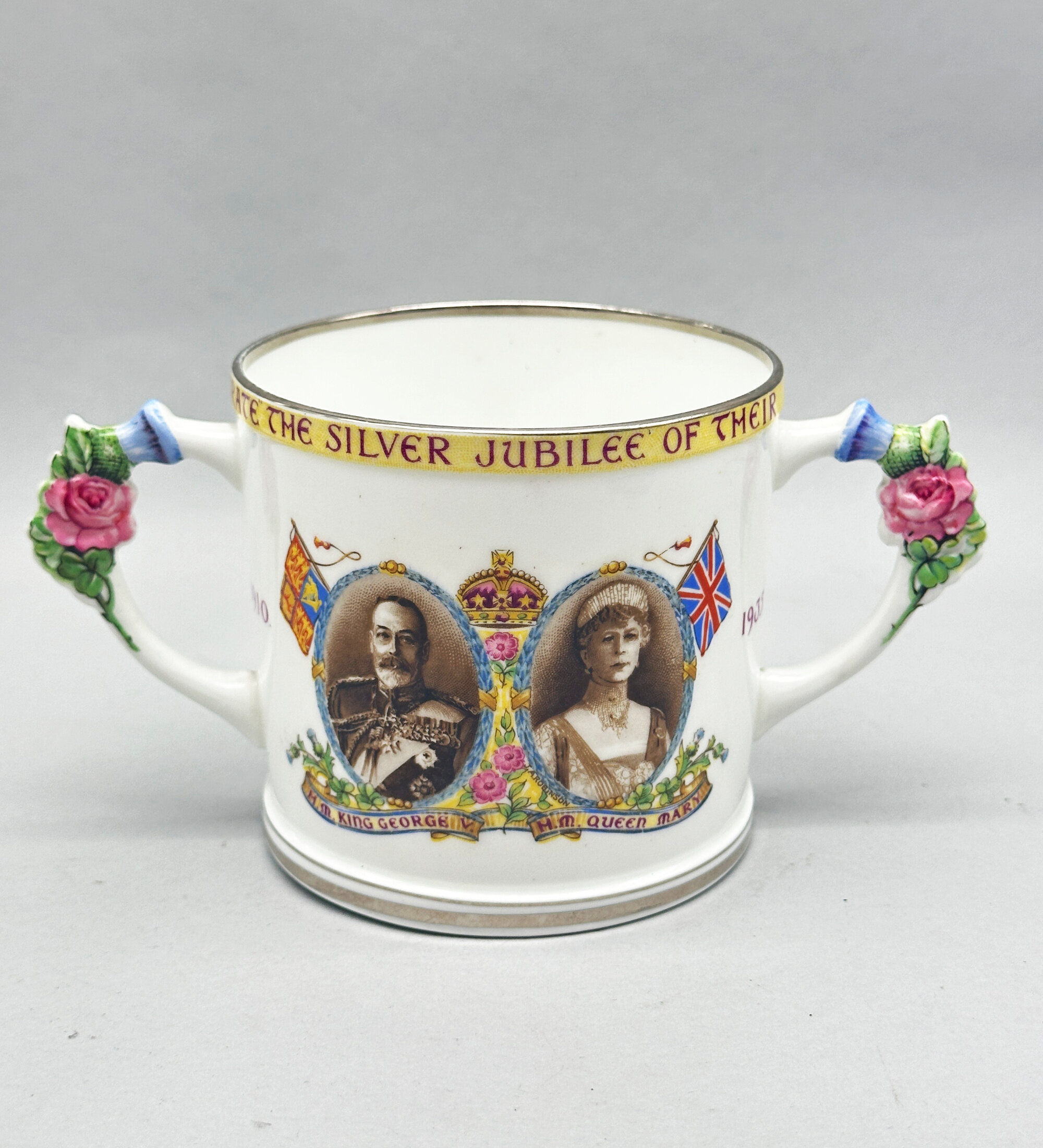
Cup Commemorating the Silver Jubilee of King George V and Queen Mary in 1935
Price: £55The Paragon China Company, formerly the Star China Company (see Lot XX), produced high quality gift items from 1920 to 1971, at first independently and then in alliance with other companies, finally being absorbed by Royal Doulton in 1972 who kept the ‘Paragon’ name until 1991. Commemorative wares were a speciality and this cup is a fine example.
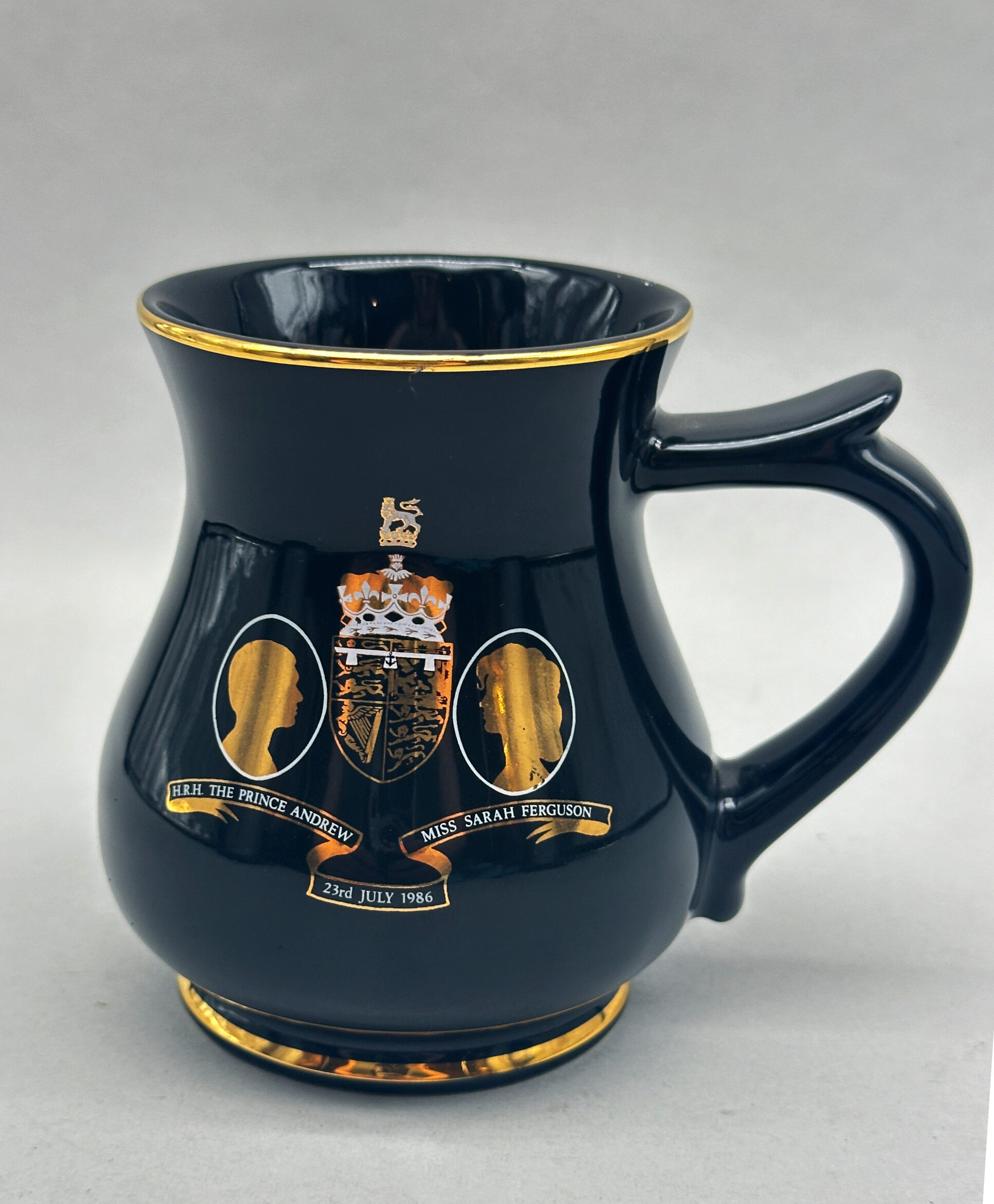
Ceramic Tankard celebrating the Marriage of Prince Andrew and Sarah Ferguson in 1986
Price: £10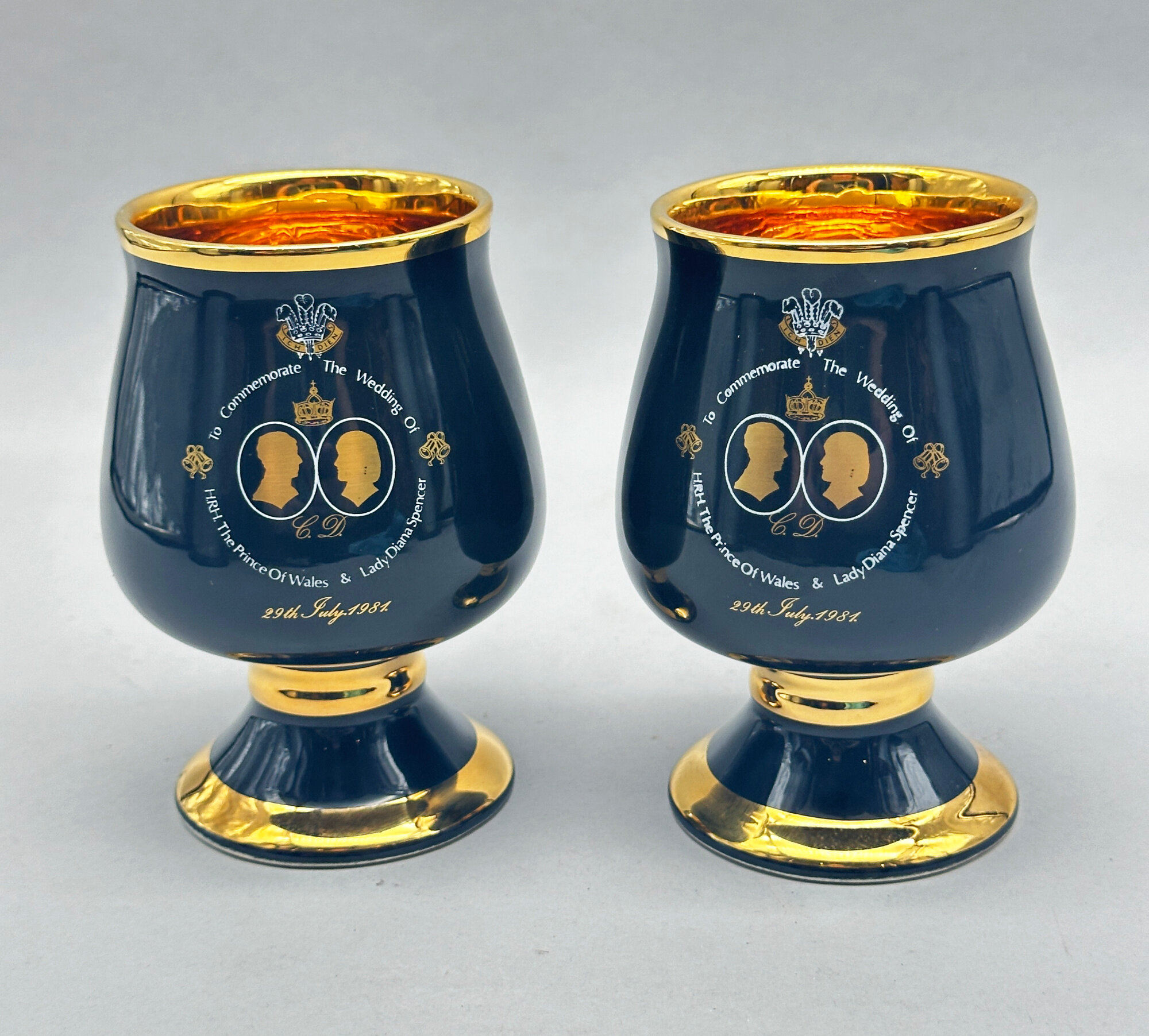
Pair of Ceramic Goblets : the Wedding of Prince Charles and Lady Diana Spencer in 1981
Price: £20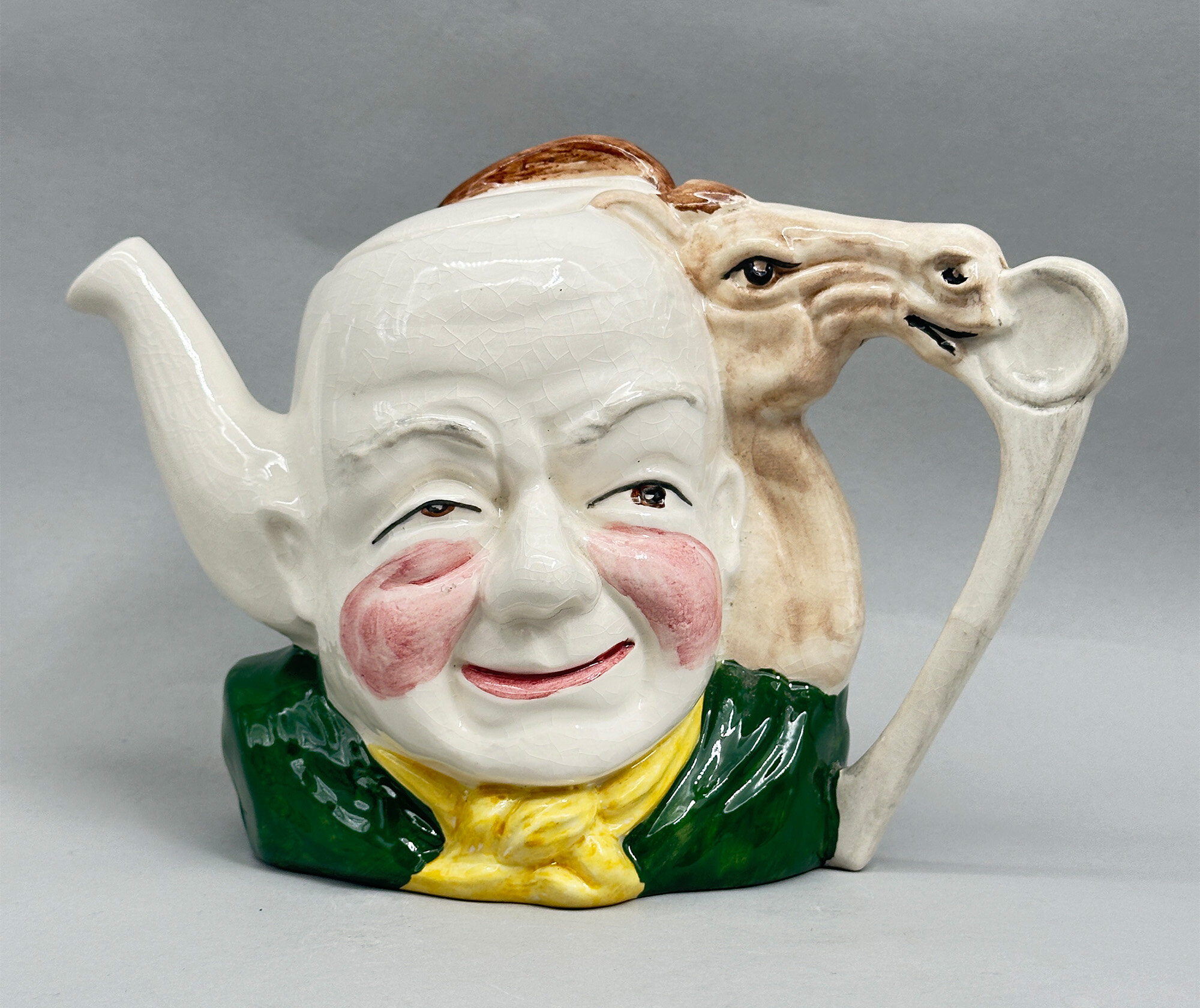
Crown Winsor Jockey Teapot, 1980s
Price: £35Crown Winsor was a short lived earthenware manufacturer at the Sylvan Works, Longton, Stoke-on-Trent, England, previously the premises of the firm Shaw and Copestake, who traded under the well known name ‘SylvaC’ and went into voluntary liquidation in 1982. A workers co-operative trading under the name of Longton Ceramics attempted to take the business over but with little success and eighteen months later the enterprise was fully taken over by United Co-operative Society and run under the name of Crown Winsor. The Co-operative society already owned the Windsor Pottery works and the Crown Clarence Pottery works which was the source of the ‘Crown Winsor’ name. Production centred on whimsical and novelty items, sometimes made from the old SylvaC moulds but demand proved weak and the business ceased trading in 1989. This teapot is typical of their range and the elaborate cipher underneath seems to read ‘CW’ grandly announcing a trade name which unfortunately had a very short life
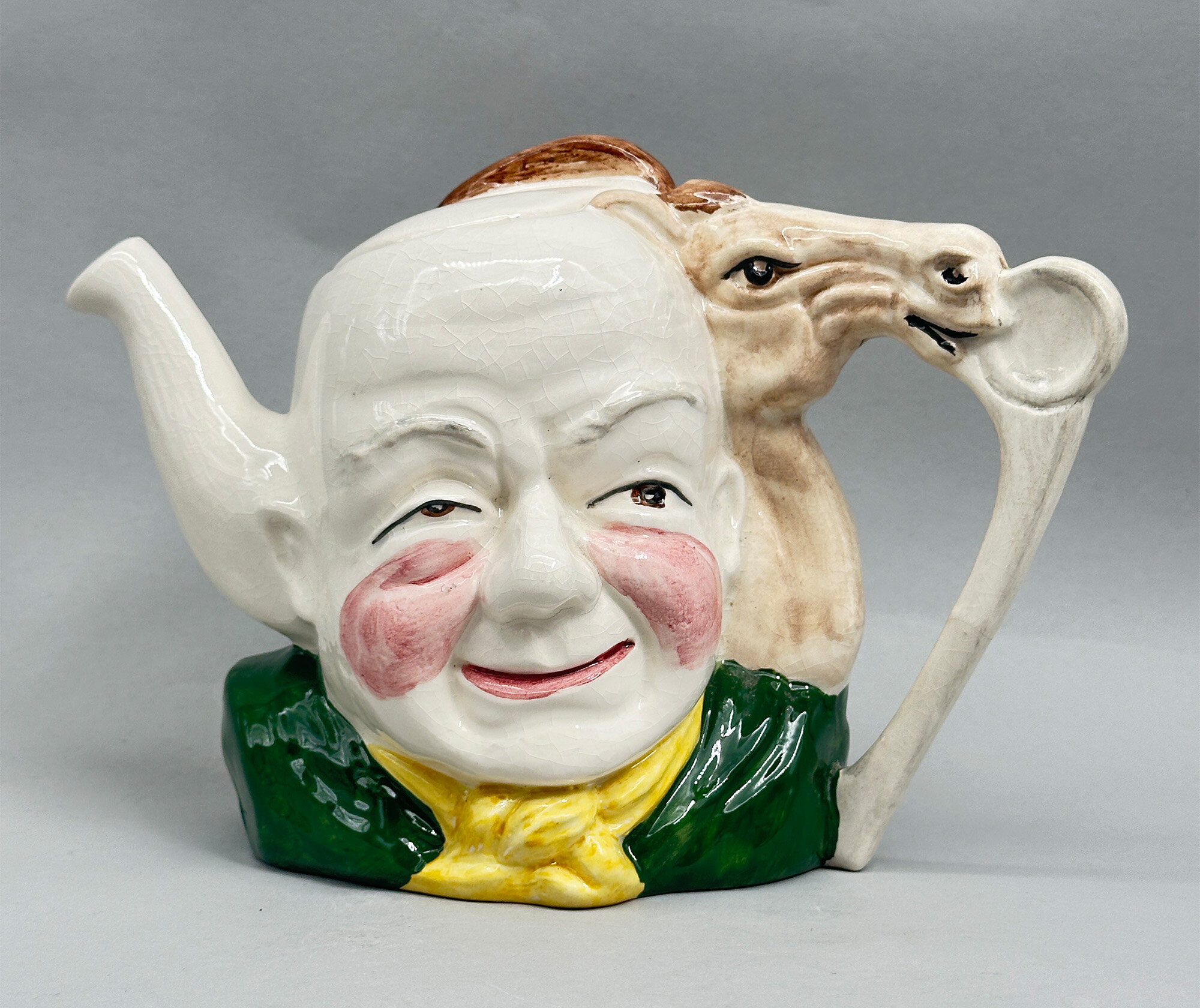
Crown Winsor Jockey Teapot, 1980s
Price: £35Crown Winsor was a short lived earthenware manufacturer at the Sylvan Works, Longton, Stoke-on-Trent, England, previously the premises of the firm Shaw and Copestake, who traded under the well known name ‘SylvaC’ and went into voluntary liquidation in 1982. A workers co-operative trading under the name of Longton Ceramics attempted to take the business over but with little success and eighteen months later the enterprise was fully taken over by United Co-operative Society and run under the name of Crown Winsor. The Co-operative society already owned the Windsor Pottery works and the Crown Clarence Pottery works which was the source of the ‘Crown Winsor’ name. Production centred on whimsical and novelty items, sometimes made from the old SylvaC moulds but demand proved weak and the business ceased trading in 1989. This teapot is typical of their range and the elaborate cipher underneath seems to read ‘CW’ grandly announcing a trade name which unfortunately had a very short life
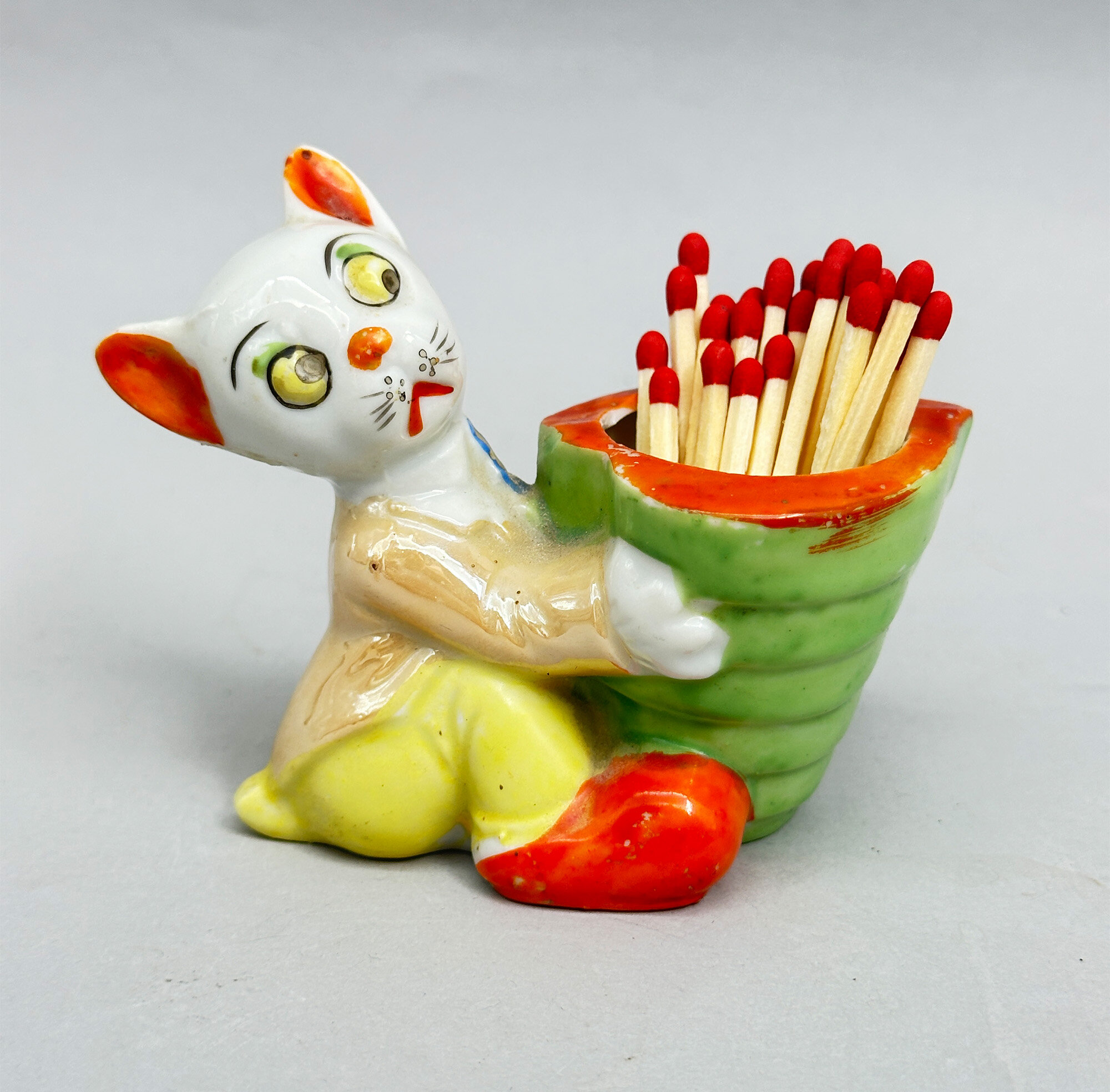
Novelty match holder with cat, Klimax Japan, mid C20th
Price: £20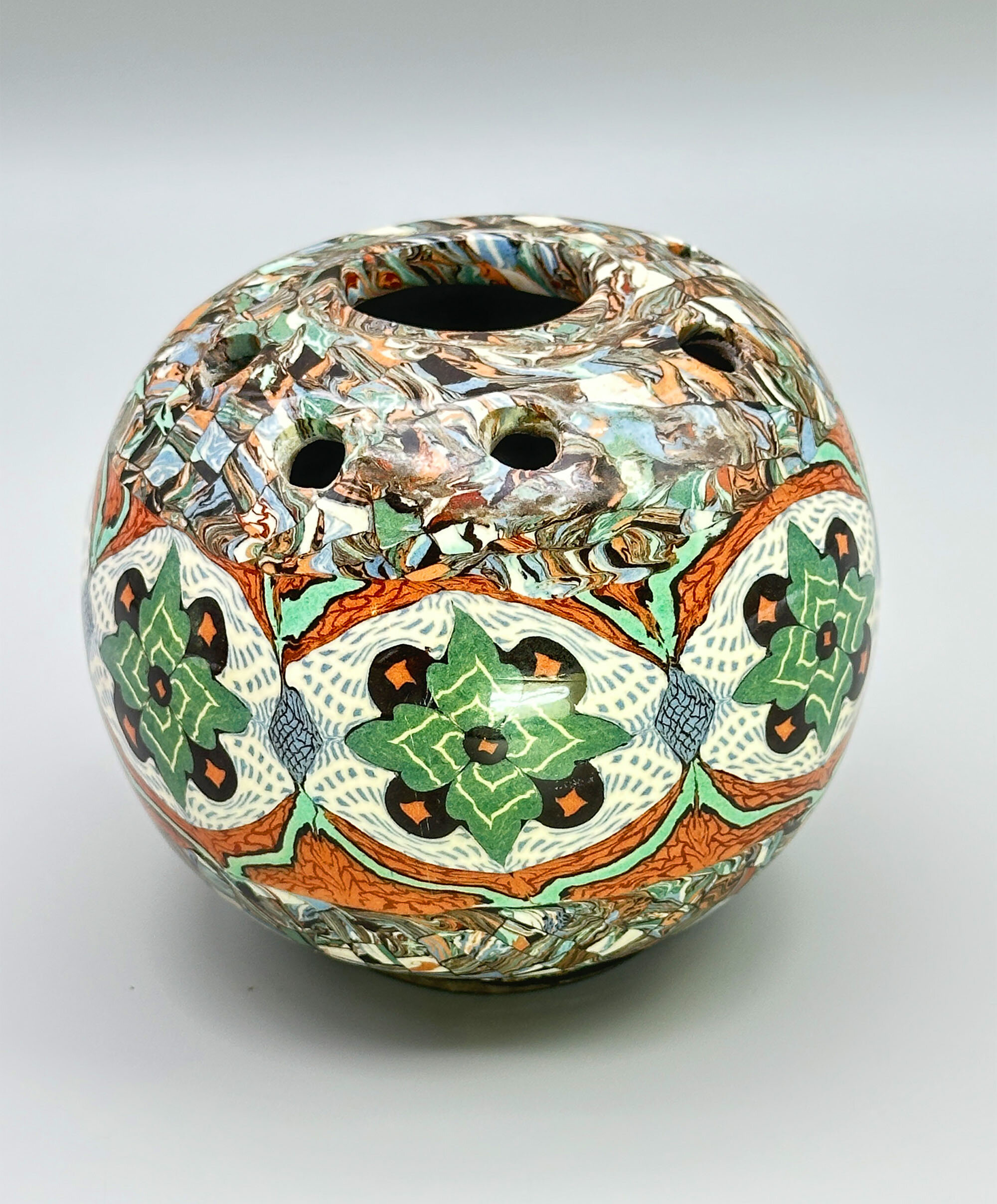
Vallauris Mosaic Pattern Vase, Jean Gerbino, signed, mid C20th
Price: £65Known for its ceramics since Roman times, when the deposits of clay found locally acted as stimulus for the production of pottery, the French Riviera town of Vallauris has been called the ‘city of 100 potters’. Pottery has been made there continuously since the classical period with a growth in production in the late nineteenth century followed by the establishment of various well known ateliers in the twentieth and the residence of Picasso himself who is said to have produced over 3500 pieces there.
Jean Gerbino Jean Gerbino (1876-1966) was a Sicilian ceramicist, who took French citizenship in 1928. He settled eventually in Vallauris and developed a unique technique combining mosaic and nériage (a mixture of coloured clays). The clays are coloured with oxides, hardened, and then assembled into plates to create colourful and distinctive mosaic patterns. These plates are then moulded, dried, and fired. The resulting forms are both distinctive and highly decorative, modern with a hint of the Art Deco era.

Delft style garniture vase, probably Chinese C20th
Price: £20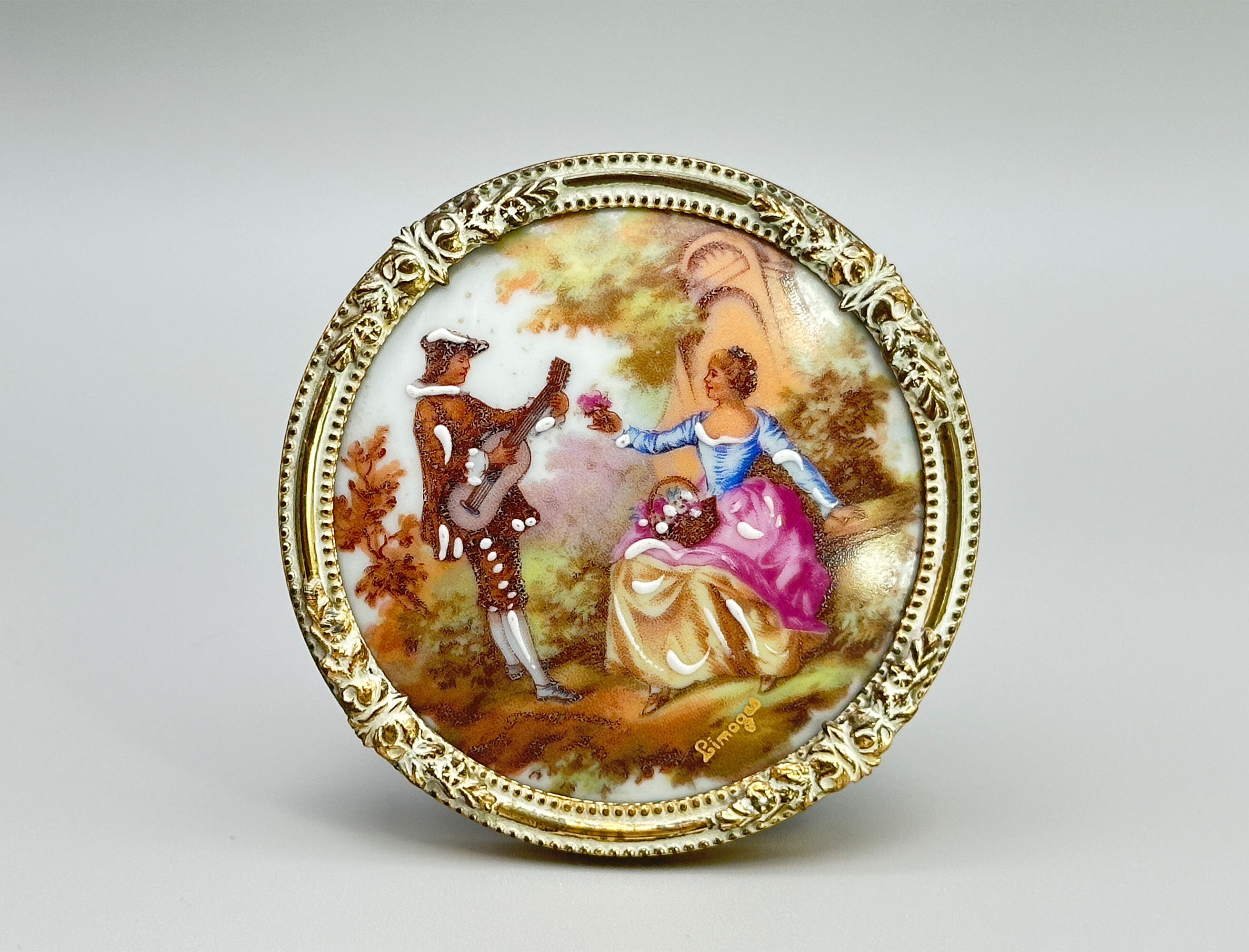
Small circular ceramic plaque after Fragonard marked Limoges, framed, late C20th
Price: £25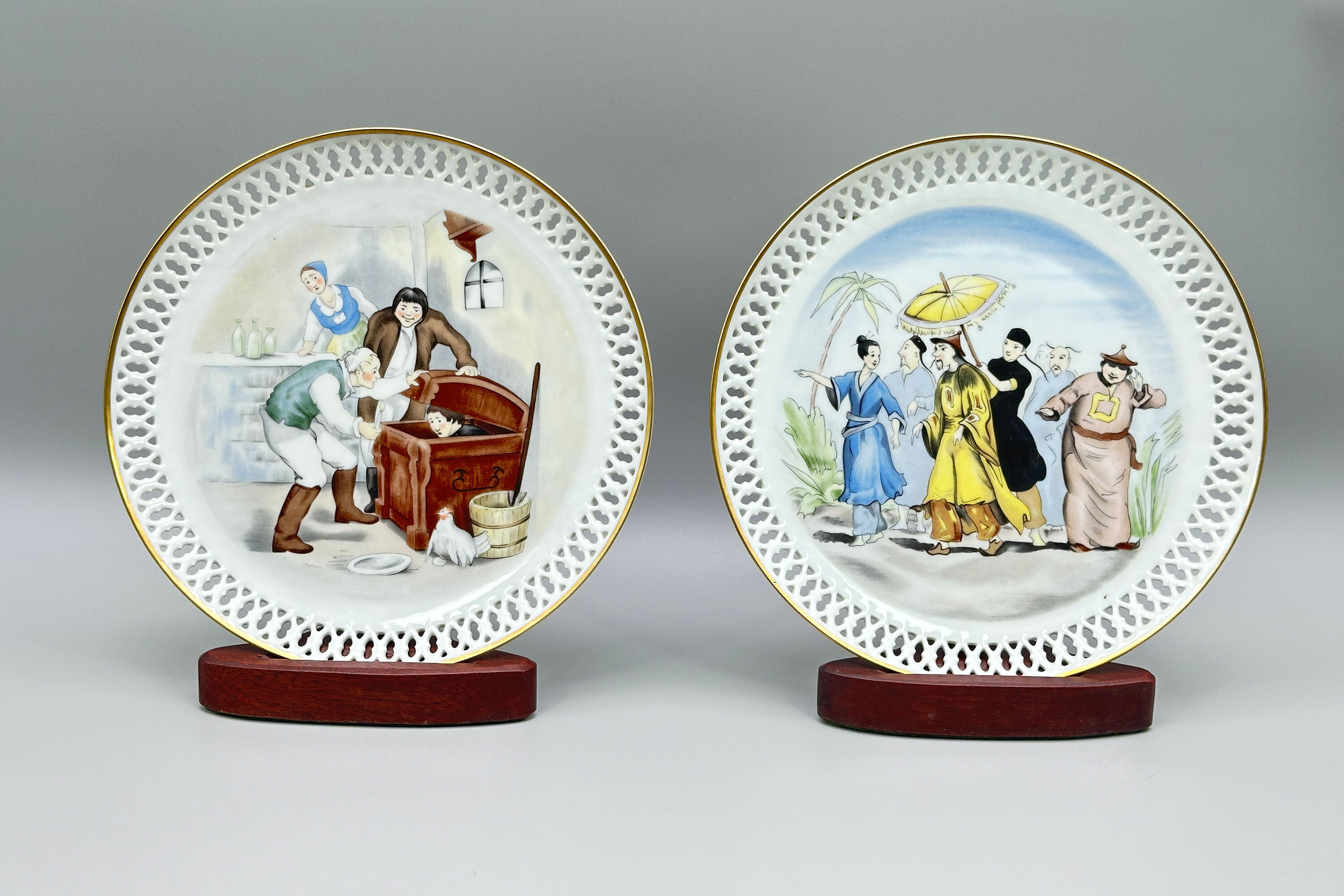
Two Bing & Grøndahl plates, scenes from Hans Christian Andersen, late C20th
Price: £45Bing & Grøndahl was established in 1853 by the sculptor Frederik Vilhelm Grøndahl and the merchant brothers Meyer Hermann Bing and Jacob Herman Bing. Their trademark, which can be seen on these two plates, was that of three towers, which was derived from the Coat of Arms of Copenhagen. Their designs proved popular and it is said that their dinnerware service in the ‘Seagull’ pattern could be found in one in ten Danish households in the 1950s. Eventually, in 1987 the company merged with its competitor, the Royal Porcelain Factory, under the name Royal Copenhagen, but some of the pieces produced thereafter still display the initials ‘B&G’ and the three tower symbol, as here. Originally sold with fitted boxes (not included here), these plates were probably produced in the early years after the merger and are sought after as collectors’ items today.

Novelty Teapot in the form of an apple, probably English, late C20th, early C21st
Price: £35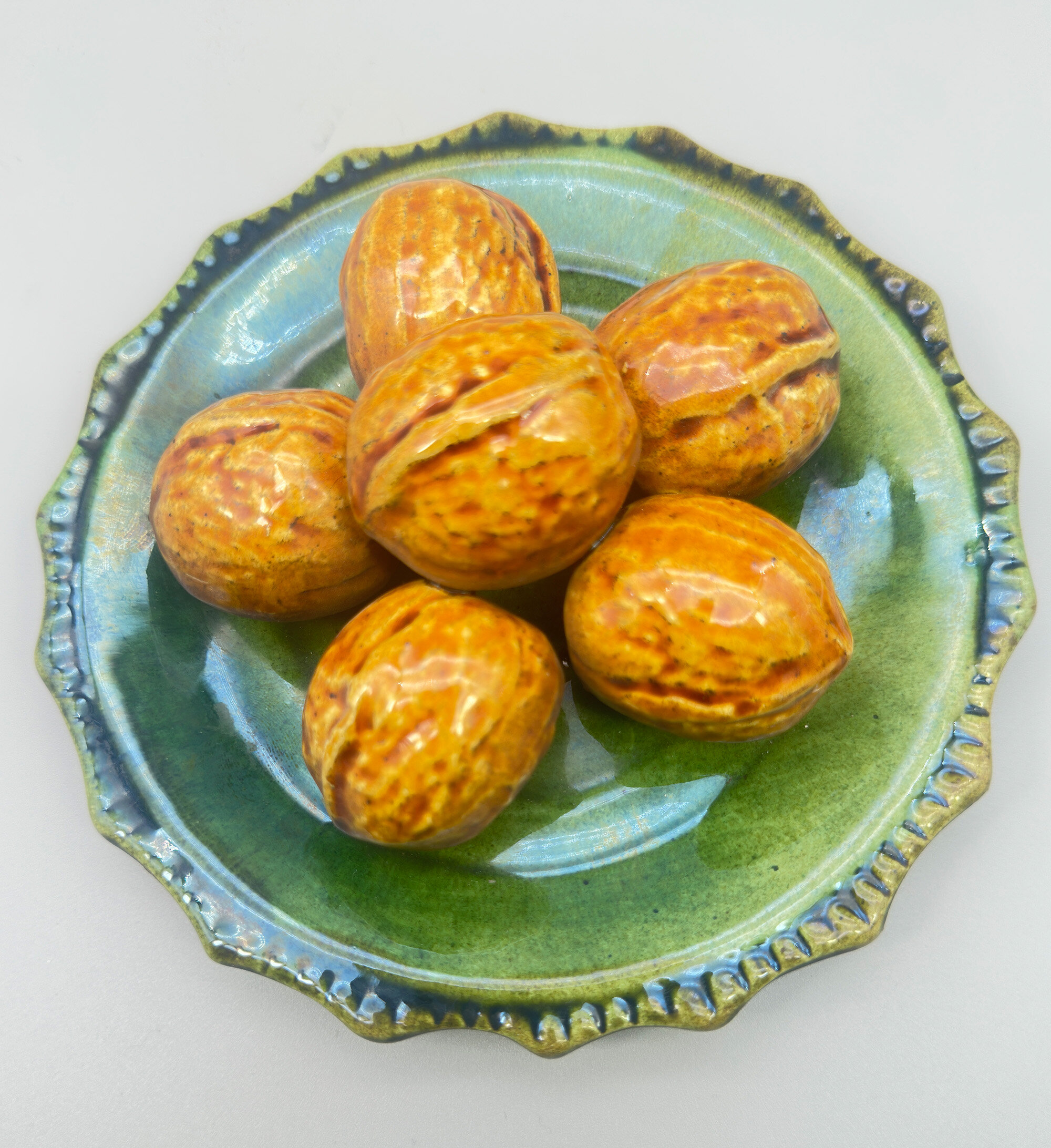
Majolica palissy style Walnut Dish, Roque Gaeiras, Portugal, second half C20th
Price: £45